Somewhere south of the equator, a vague line is drawn around some islands. We call this area Oceania.
From Papeete to Perth, Oceania is connected by ocean rather than land. The whole damn lot of it is all a bit dreamy, a bit mysterious, and a bit wild (yes, the places AND the locals). 😉
Travellers sometimes get distracted by the two major Lands Down Under – Australia and New Zealand. But backpacking Oceania goes well beyond Australia and New Zealand and out into the Pacific.
This area is imprinted into my mind like the words to an old favourite song. I have lived in and travelled to Oceania for years. I know all the best spots – and the slightly overrated ones!
Above all, I know that backpacking Oceania is a damn combo deal. One week it’s getting beers in an outback Aussie pub and the next it’s bartering for coconuts deep in the jungles of Vanuatu.
Look, the Lands Down Under are not known for being cheap. But there’s nothing like sheer beauty and exorbitant prices to ignite the scroungy inner dumpster diving hitchhiker in all of us!
And I’m here to help you navigate a path through the best places to go, the must-sees, and the inspiration to forge your own itinerary (all while keeping to your budget)!
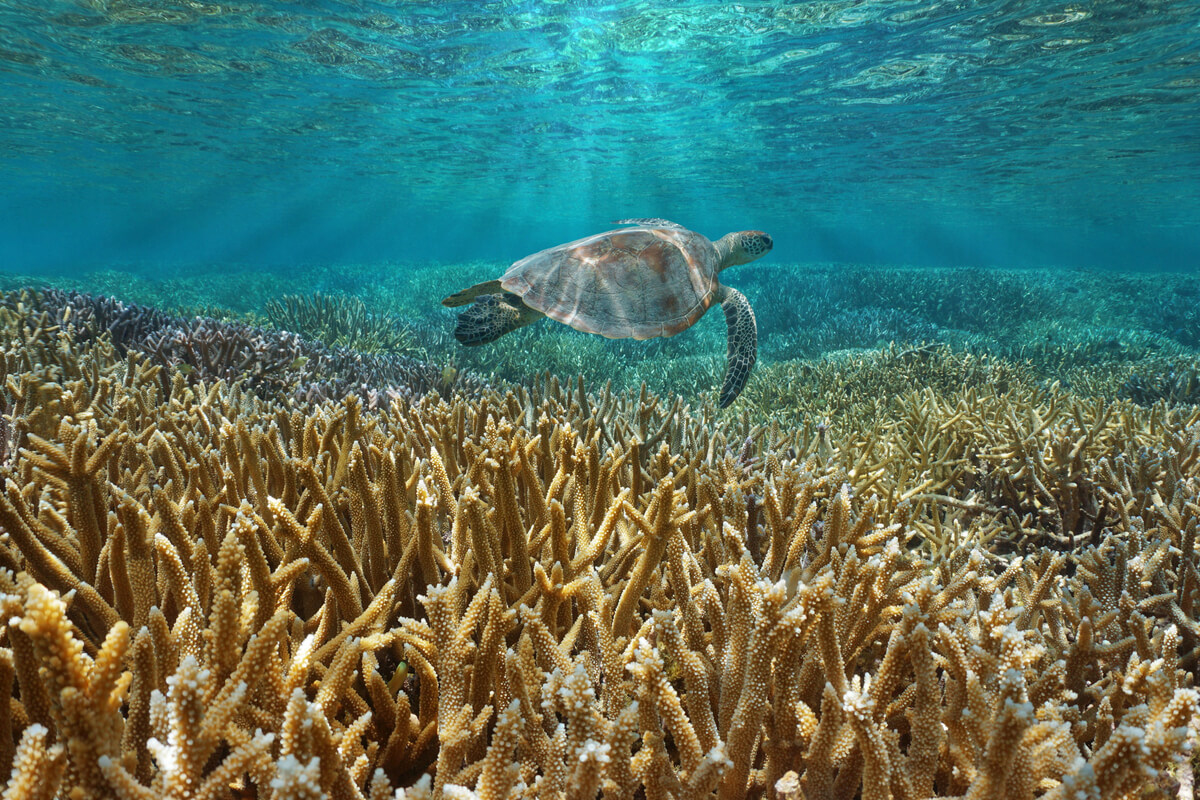
The Broke Backpacker is supported by you. Clicking through our links may earn us a small affiliate commission, and that's what allows us to keep producing free content 🙂 Learn more.
Why Go Backpacking in Oceania?
The wibbly-wobbly line that we draw around Oceania comes to include a lot of water. The surf bum, the sailor, and the diver are sure to find their Eden here while backpacking Oceania.
The sun-seeking backpacker – perhaps finding their feet on their grown-up gap year – will be blown away by the incredible beaches. But rest assured, for those of you who see sand as the devil’s exfoliant, Oceania is more than just the world’s best surf breaks.
After all, New Zealand is full of snow caps beautiful enough to make you weep.

Photo: @danielle_wyatt
Now, in case I haven’t stressed it enough yet: travelling to Oceania has a bit of everything. For the city slickers, we have ample latte culture and groovy bars full of ironic mullets. The islands further out into the Pacific are known for being rather classy affairs, too
What all of Oceania has in common – is its remoteness. You truly have to write your own manifesto out here. Once you hit the open road – or open ocean – you’ve got to be prepared. There’s no turning back.
- Best Travel Itineraries for Backpacking Oceania
- Best Places to Visit in Oceania – Country Breakdowns
- Top Things To Do in Oceania
- Backpacker Accommodation in Oceania
- Oceania Backpacking Costs
- Best Time to Travel to Oceania
- Staying Safe in Oceania
- How to Get Into Oceania
- How to Get Around Oceania
- Oceanic Culture
- Some Unique Experiences in Oceania
- FAQs About Backpacking Oceania
- Final Advice Before Visiting Oceania
Best Travel Itineraries for Backpacking Oceania
There is never going to be an itinerary that fits all of Oceania into it. This area is so vast – and full of so many places to see – that you’ll always be leaving something out!
I don’t see much point in rushing around the countries. You might as well slow down, use your phone less, and enjoy the ride. Picking a couple of countries and a few places you want to see will allow you to enjoy your travels to Oceania more.
So here we have a few options: we’ve got something for those short on time and something for those with nothing but time! Either way, this delightful slice of paradise is going to blow your socks off.
4-Week Travel Itinerary for Oceania – The Basic

If you’re short on time, this is the itinerary for you!
I really think this is the minimum amount of time you want to spend backpacking Oceania. You can get a taste of the good life Down Under and hit some of the most famous spots.
You can do a quick road trip down the east coast of Australia to see the famous Gold Coast, Byron Bay headland, Bondi Beach, and Sydney Harbour Bridge. A cheeky stopover to backpack Melbourne wouldn’t go astray.
There’s plenty of opportunities to get off the beaten path too – simply take a wrong turn on a highway and drive through rural NSW. You may end up doing your own version of dark tourism and driving through where Ivan Milat committed the infamous backpacker murders.
Taking a flight across the Tasman to the North Island of New Zealand is your best bet. There is plenty of flexibility in your itinerary if you rent a car here too. Maybe you want to go into the wild and picturesque Northland or head east through the Bay of Islands.
Maybe you want to explore Wellington and sip lattes at the art museums. There are vineyards and hot pools; hiking and diving are all to be experienced.
3-Month Travel Itinerary for Oceania – The Sailor
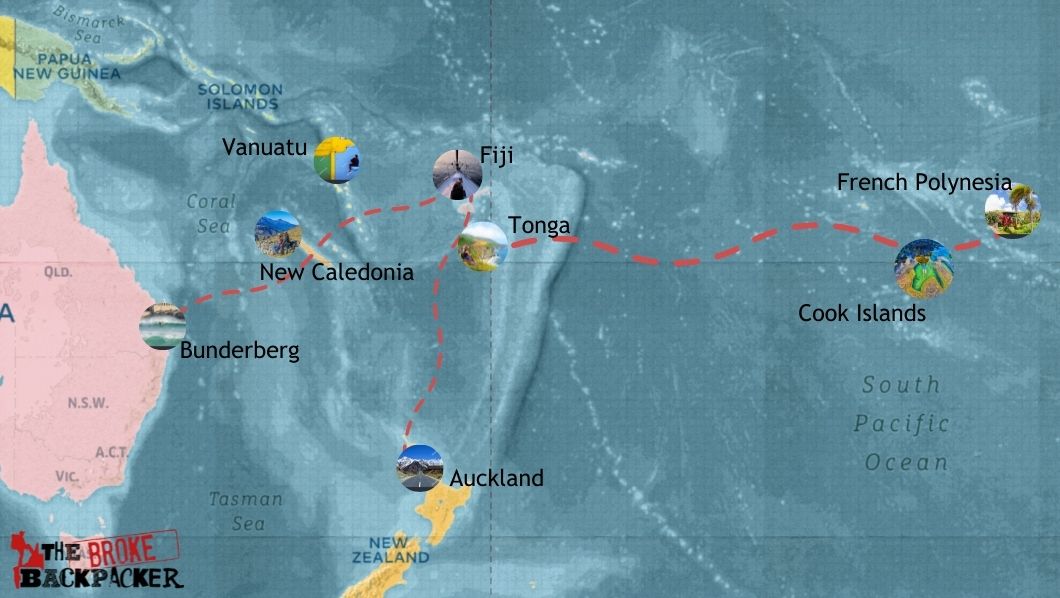
Fresh off the back of a Pacific ocean crossing, you can spend a good sailing season cruising the Pacific Islands of Oceania. Your first port of call is likely the Marquesas – magical lands of volcanic jungles and sweet-ass mangoes.
Most sailors will get stuck in the Tuamotus and their warm, diverse diving. They’ll swing past Tahiti to stock up before continuing onwards. Always, they follow the trade winds.
Maybe they will stop in the Cook Islands. There are certainly uninhabited, or barely inhabited atolls to explore here! Or perhaps they will go onwards to Tonga or Samoa. Travelling in Fiji also offers a lot to both the tourist-type as well as the veteran boatie.
Toward the end of the cruising season, they may hook a south and go to New Zealand, or they may stop in at New Caledonia and continue on to Australia.
What is certain is that these sailors have an epic few months of adventuring in the Pacific to be done! Fresh mahi-mahi, remote anchorages, and starry nights await the intrepid explorer who takes on this route.
6 Months Backpacking in Oceania – Broke Backpacker Style!

So you wanna go troppo and become an Oceania local? This itinerary is suited best for those spending an extended period in Oceania. At some point, they’ll probably have to hang up the dirtbaggery and get a travel job to fund some legs of this adventure.
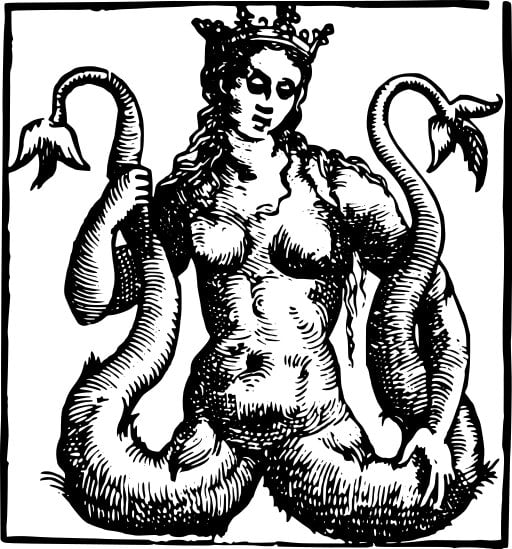
Photo: Anonymous (WikiCommons)
But you’d start at the most western point – in Western Australia. You’d see the best of this ancient continent by spending a good chunk of time in the Kimberly. Then you’d explore the great southern region, and catch your first waves in Margaret River.
Taking a road trip through Australia’s most iconic stretches of landscape is not going to disappoint you. There’s the Nullabor, the great Australian bite, the great ocean road, and backpacking Sydney to fit in.
Be sure to visit the Red Centre and Uluru before you jet off across the Tasman. The North Island and the South Island of New Zealand have adventures in store for you!
The hustle and bustle of Auckland’s famous fish market gives way to the rolling plains of the Waikato. Sunny Nelson and Golden Bay soon disappear beyond mountains and the blustery Bluff.
The Cook Islands are a natural addition to this trip. And, if you can manage, a trip to Fiji or beyond is even better. Thought the weather was good in Australia? Wait until you get to Tahiti!
The long-term drifter will be able to shore up their skills and find work on a sailboat if it suits them. Because once you leave continental Australia and New Zealand, the travelling of Oceania by sailboat becomes far superior.
Want to save money on your trip?
We got you. For reals.
Best Places to Visit in Oceania – Country Breakdowns
Oceania is big, but – other than Australia – the countries that make it up are not. If you are backpacking New Zealand, with a little planning, you can easily see a lot of the best of the country. The same goes for the Cook Islands and French Polynesia. Travelling to Oceania is about being smart with the time you have.
Backpacking Australia is another kettle of fish. She’s big, she’s bold, she’s beautiful. Really, each of its states act (sometimes for the worse) as their own countries.

Photo: @willhatton__
What is true throughout travelling to Oceania is that, if you scratch the surface, you are going to experience cultures and landscapes that are unlike anything else in the world. One minute it’s hightailing it down a dirt road while being chased by an emu, the next it’s sailing through uninhabited islands. Always, it is remote and untouched.
A Zigg-alicious Interlude

The Broke Backpacker Team is full of some pretty special humans. Life works in mysterious ways and somehow Ziggy and I share a (shitty, but only we can call it shitty) hometown.
Oceania is as mythical to us locals as it is to the uninitiated traveller. We travel it in search of home.
Anyway, the Zig-anator is an East Coast Aussie native who went back after some overseas vagabonding and did the dirtbaggery trifecta across his home state: van life, busking, dumpster diving.
Now, I can think of no one better to pass on the best places to visit on Australia’s east coast (alongside the overrated hometowns).
So bam! Have a super sexy collab and strap in for Ziggy’s supercalafraga-DELICIOUS must-sees of our motherland’s eastern seaboard.
Backpacking East Coast Australia
Beaches! It’s east coast Australia, baby. That means you hit the beach, and if you don’t, we deport ya!
Truthfully, backpacking Australia’s east coast is a lot more than just the coast. Australia’s eastern seaboard has a lot to offer, but you gotta be willing to actually leave the beach.
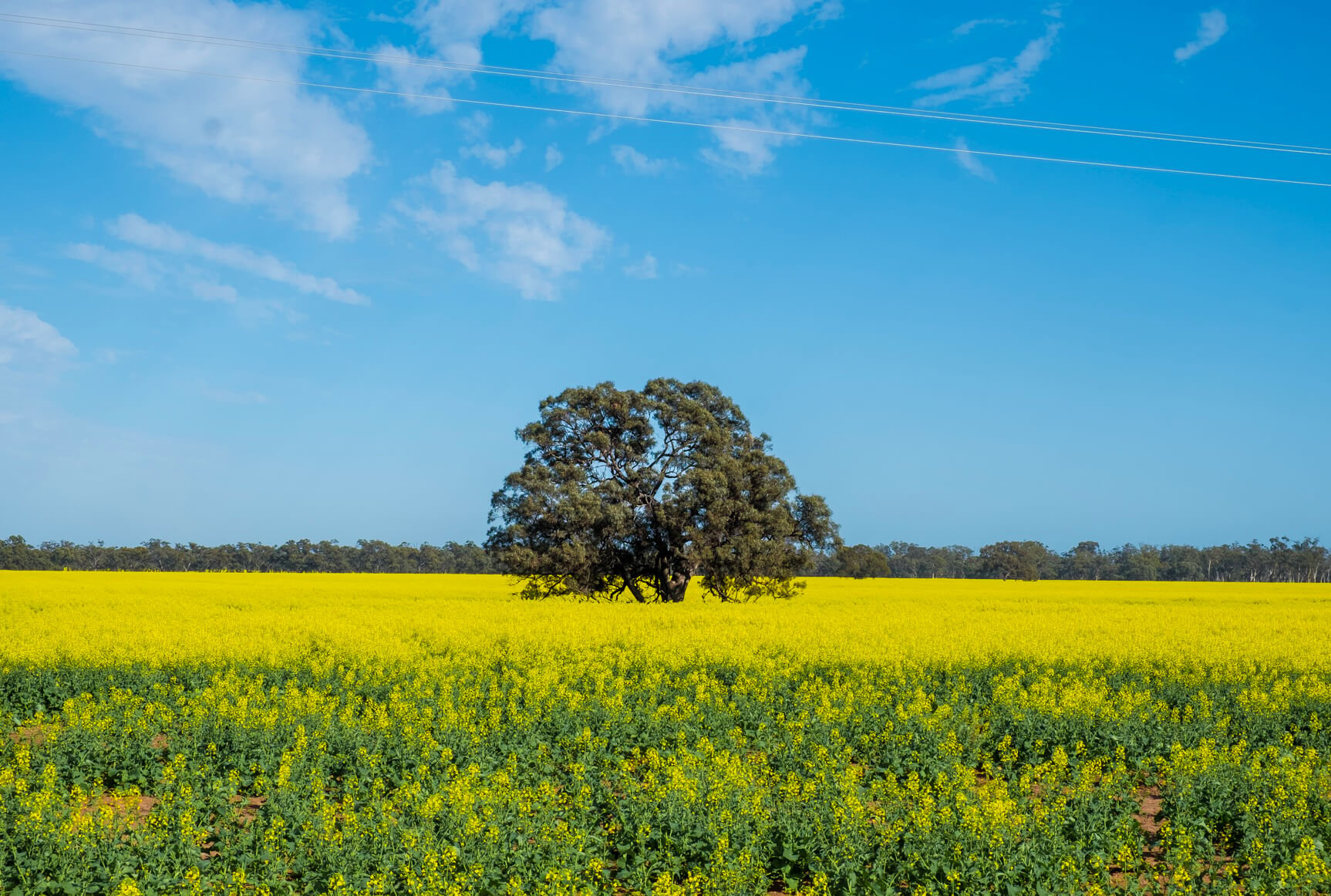
Photo: @themanwiththetinyguitar
Lovers of a good hike will find out that, yes, Australia does actually have mountains. They tend to just be more expansive gnawing wildernesses rather than devasting pyramids peaks. But shit, man – dey good mountains.
Now in order of most sexy to not-quite-as-sexy, I give you:
- The Blue Mountains (NSW)
- The Snowy Mountains (NSW)
- The Grampians (VIC)
- The Glasshouse Mountains (QLD)
- and the Victorian Alps (VIC)…
Coastally, it all checks out too. You start in the tropics in far north Queensland (which is actually hella offbeat), moving down to the sub-tropics around Cairns (another backpacker favourite) and the Gold Coast, and then it’s temperate waters all the way down through New South Wales before hitting the south coast of Victoria (which is home to some EPIC road trips).
And even though I may have many many (many) quandaries with them, both Sydney and Melbourne offer a lot: art, culture, wicked music scenes, good food, good nature, and oodles of fun tourist activities. Brisbane also offers a lot too, if you have a penchant for cities that offer absolutely nothing.
Look, the east coast of Australia is overdeveloped, overly expensive, and overtouristed. But hot damn is it pretty! And as you’ll discover most places in little ol’ Oz, get off the highways and start taking the backroads inland, and it gets real wild real quick.
What to Know Before Visiting East Coast Australia
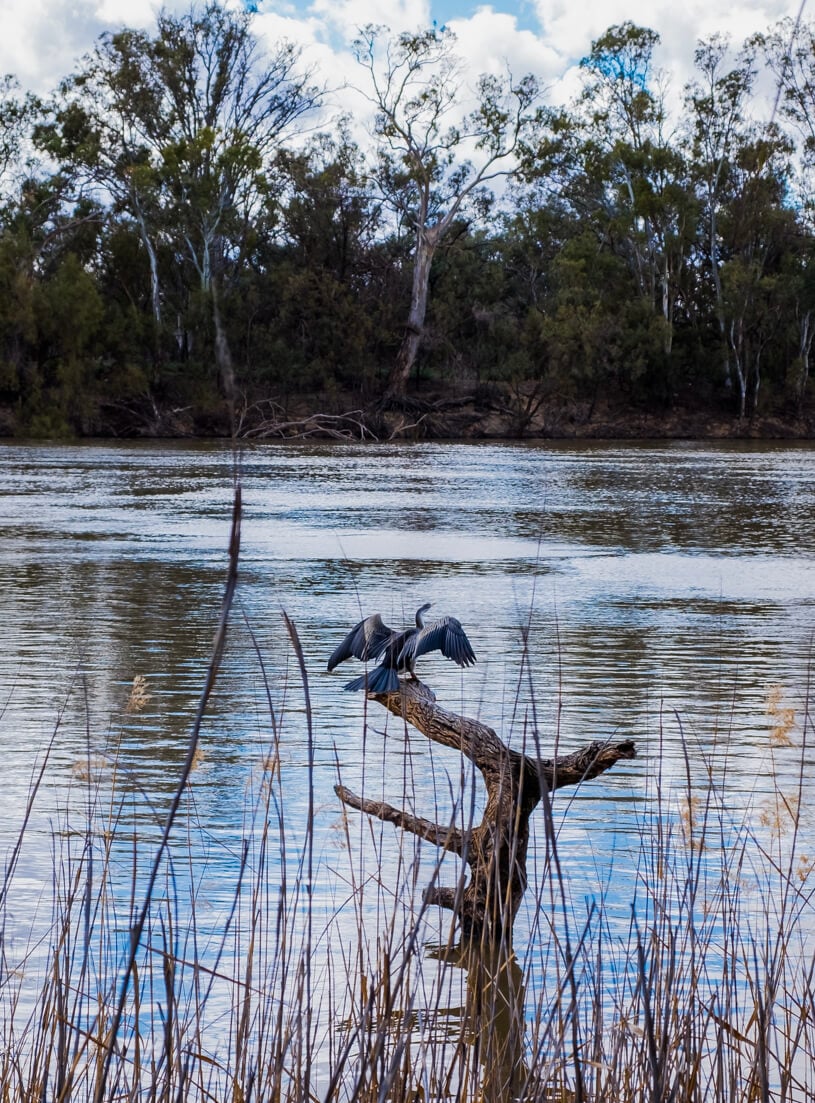
Photo: @themanwiththetinyguitar
- Don’t miss out on… ANYTHING NOT ON THE COAST. Seriously, just drive inland to the regional and rural areas. Carve the backroads, ditch the highways, and go see what life is like for the other 90% of the continent that’s been forgotten.
- You know what’s overrated… As a Byron Bay born and bred vagrant, I can safely say with absolute confidence that Byron is a total shithole. Overrated Travel Experiences 101. Try Bellingen if you’re looking for old-school hippy vibes. (The Gold Coast sucks farts too.)
- The coolest hostel is… The Arts Factory in Byron Bay. Wait what? Yeah alright the town went the way of the dodo, but the Arts Factory has been part of the Byron Bay backpacking experience for decades and I gurantee you’ll still meet a host of colourful loose cannons there even now.
- The best food is found in… Springwood Kebab House, Springwood, Blue Mountains. Unfortunately, I don’t get to go back because my very unhinged ex told some very untrue stories about me to the owner after we split and now I’m pretty sure he spits in my kebabs. But you should go for me!
Backpacking Tasmania
Yes. Australia DOES have mountains. And the best of the best you find in Tassie.
As an east coast born Aussie, I never fell in love with Australia. I never got Australia. And then I went and lived the van life in Tasmania: Tasmania is Australia as it should be.
Environmentally, Tassie is about as pristine as Australia gets. We’ve scarred the land, but she’s far from done. Primordial forests decorated with colossal gums and mountains that humble your gaze. Oh, and a road trip around Tasmania involves more kamikaze wildlife diving under your tires than you’ll see anywhere on the mainland.
Historically, Tassie is about as dark as Australia gets. Genocide and cannibalism make for the local campfire stories. But it’s strangely heartwarming to know that once you step off the east coast, the roots of Australia’s sordid history still remain. I’ve driven through backwater hamlets in Tas where the voice in my gut said “Do not stop; do not get out.”.
And I love it so much.
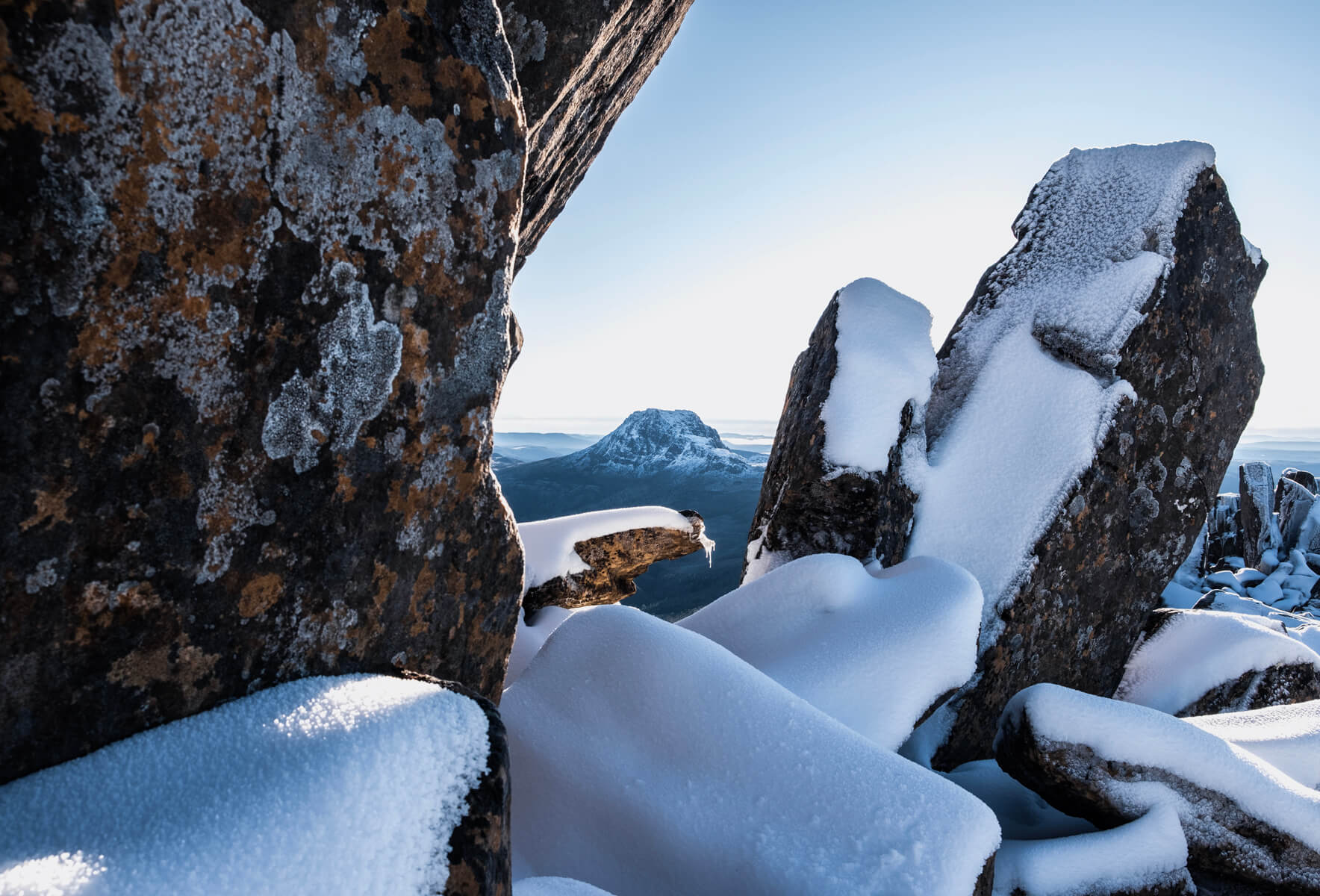
Photo: @themanwiththetinyguitar
A trip to Tasmania can be as low-key as you like: potter the east coast, hike Cradle Mountain, and visit Hobart and the MONA. Or it can be as real as you want: wander the Central Plateaus for weeks, brave the ghost towns of the West Coast, and get into a drunken punch-on in Launceston followed by a 3 A.M. recovery kebab (a rite of passage for all Tasmanians).
But whatever you do and however you do it, one core tenet of Australia remains in Tasmania: you do you – no wuckas, mate. Cause if you do you wrong in Tassie, the locals will sort ya out.
What to Know Before Visiting Tasmania
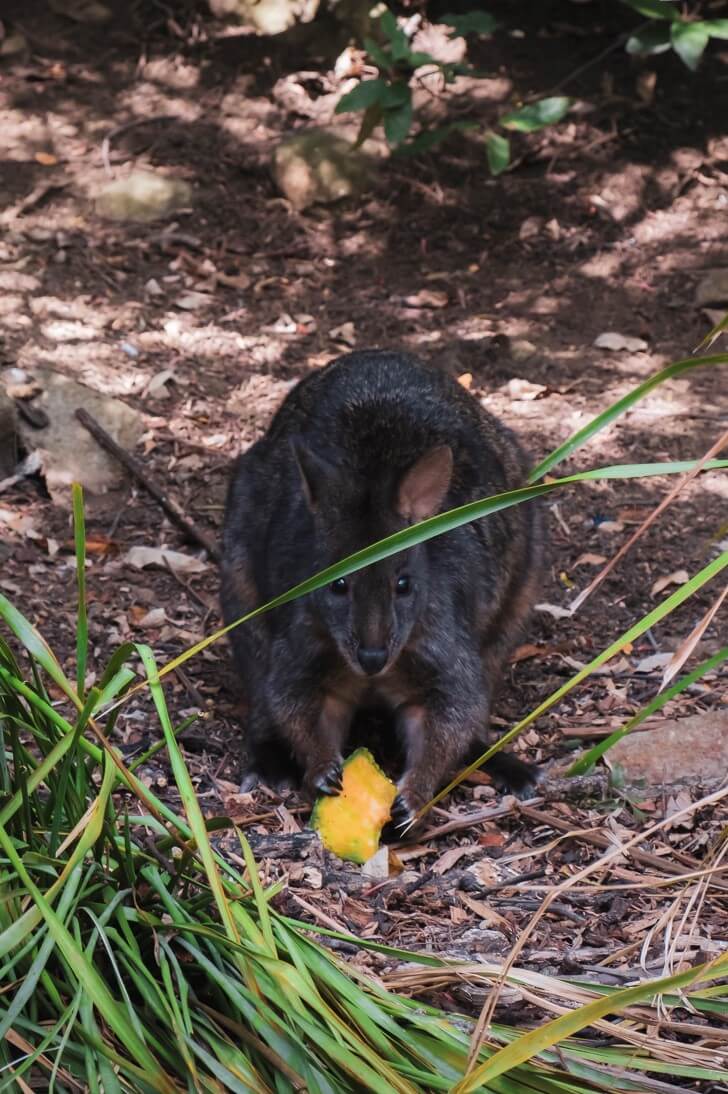
Photo: @themanwiththetinyguitar
- Don’t miss out on… The Walls of Jerusalem National Park. Dat shit puts Cradle Mountain to shame. If you just want to walk and walk (and camp) and then walk some more, undisturbed, then the Central Plateaus shall be your stomping ground.
- You know what’s overrated… Ok, legit unpopular opinion: the MONA is super pretentious (with some bombass architecture) and Hobart is just the Sydney of Tasmania. Sure, it has 10% of the population, but the people are 100% equally unhappy about their life choices.
- The coolest hostel is… Hostel? Dude, you’re doing Tassie wrong. Get a van.
- The best food is found in… In buttfuck-nowhere roadhouses near creepy murder-vibe towns. Chips with gravy are the national staple of Tasmania, and you’re gonna love it!
Backpacking Western Australia
Well, that was a tasty take on East Coast Australia. And now, we return to our regularly scheduled programming of Indigo Radio. Also, the West Coast is the BEST coast (don’t fight me on this, Ziggy).
When I go travelling, people inevitably ask me about home. Home for me is Western Australia and I find it hard to explain just how damn beautiful it is. Because it’s not full of glamorous cities. The landscapes can’t be captured in European style paintings, or even by the highest-tech Nikon camera.
For so long there’s only open space, shrublands, and empty river beds. You can’t frame it – only feel it. This is the land of the ancients.
If we’re on the same page, you’re sure to dig Broome too, It’s an exotic location that is fast gaining a spot on people’s bucket lists. You’ll find affordable and quirky hostels that add to the whole vibe.
- WA has the oldest rocks in the world. They are called Zircons and are found 800 kilometres north of Perth at Erawandoo Hill.
- WA also has one of the oldest known forms of life – Stromatolites. You can find some of them in Shark Bay and Marble Bar.
Did I drive a busted up Toyota Hiace through Western Australia searching for the oldest rocks and stromatolites in the world? You betcha! As is typical in much of rural Australia, the road stops were usually ‘full’ of road train drivers and the odd farmer. Inevitably they had to ask what the heck me and my busted up old van were doing in the furnace-like heat.
“Looking for rocks? You gone funny in the head or something?”
Western Australians are not known for their subtlety.

Image: Nic Hilditch-Short
Backpacking Western Australia can feel like stepping back in time – literally. There is a very untamed wilderness full of kangaroo hunters, red dirt, some aboriginal communities, and not much else. But by crikey, she’s beautiful.
Each region feels like its own country. Before colonisation, there were language groups across the connected countries of Western Australia.
And it’s not all old rocks and road train drivers who make fun of you (but also help you fix your engine). You have the Ningaloo Reef which rivals the Great Barrier Reef.
There are the hippies of the great southern town of Denmark. There is wine a-plenty and world-class surf in Margaret River. And of course, there are vibrant backpacker hostels in Fremantle that keep the vagabond spirit alive.
Many of the towns down south end in ‘up’. In Noongar, this means ‘place of’. So for example, my hometown is made up of Yallingup (Place of Love) and Wonnerup (Place of the Woman’s Digging Stick).
And yes, even the world’s most isolated city – Perth – really isn’t that bad. You’re only allowed to make fun of Perth if you live in Perth. Because with good wages, good weather, and a laid back culture you really can’t go wrong backpacking in Perth!
What to Know Before Visiting Western Australia

Photo: @indigogoinggone
- Don’t miss out on…the Gibbs River Road – this is an EPIC 4WD trip that highlights the BEST of Western Australia. You do have to be prepared but then the road rewards you 1000x.
- You know what’s overrated…anywhere that more than 20 people have congregated at. Western Australia is too damn big and remote to cram yourself into a place like sardines.
- The coolest hostel is…Cable Beach Backpackers Broome. Here’s where you come to find work, new hostel friends, and a cheap place to stay in paradise!
- The best food is found in…the bush. Even if you bring your own two ingredients and make damper – everything tastes better out of a campfire.
 Check out the coolest places to go in Perth.
Check out the coolest places to go in Perth.
 Then plan your trip to Perth!
Then plan your trip to Perth!
 Book one of Perth’s finest Airbnb accommodations.
Book one of Perth’s finest Airbnb accommodations.
 Or check into on of Perth’s best hostels!
Or check into on of Perth’s best hostels!
Backpacking the North Island of New Zealand
The North Island has most of the people in New Zealand – and still plenty of wilderness going on.
The biggest city in New Zealand is Auckland. Visiting Auckland offers a lot for the humble backpacker! There are markets and nightclubs, and even though I think the real fun lies outside the city, it’s definitely worth a visit!
The Bay of Islands is going to draw in all the sailors. It’s got tropical, prehistoric, and Pacific looking islands surrounded by freezing cold waters. There are dive sites, beaches, fishing, and general water-baby-stuff galore.
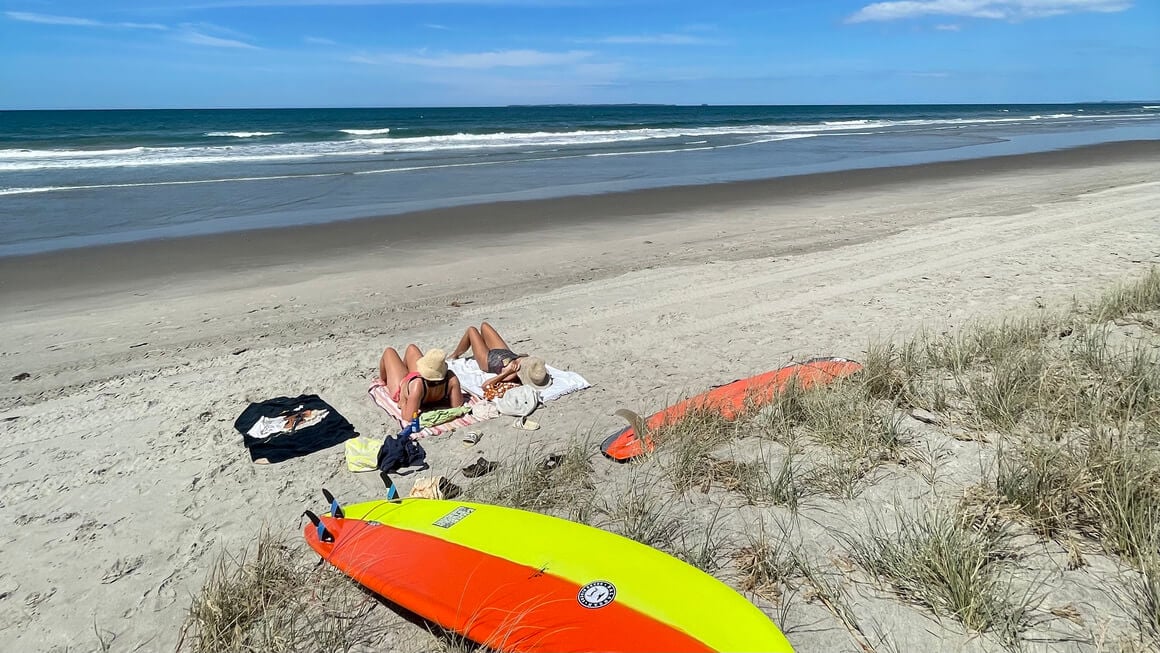
Photo: @danielle_wyatt
The East Coast of the North Island is a little wayward. The landscapes are rugged and the coastline is pummeled by epic surf every time a front comes through. The people are a bit wild too. Sure, you can relax in the sun here, but be prepared for an adventure to strike at any moment. You never know when you’re going to get roped into a week-long fishing expedition, or taming wild horses with your new neighbour’s old friend.
Despite having most of the population of the country, the North Island never really loses its rugged feel that is unique to Oceania.
Even Wellington – the capital city – feels more like a small town full of creatives and artists than it does a city full of government officials.
What to Know Before Backpacking the North Island, New Zealand
- Don’t miss out on…Te Papa. This is the National Museum of New Zealand and you don’t have to be a nerd to appreciate how freaking EPIC it is. Every time I go to Wellington, I make sure I stop in and ask to see their extensive fish collection run by a (not quite) mad taxonomist.
- You know what’s overrated…Auckland. Yeah, I know I said it was worth a visit (and it is!) but there is so much else to see in the North Island that is not a congested and overpriced maze of a city.
- The coolest hostel is…The Flying Nun, Gisbourne. Look, it’s maybe a little crazy but it’s got a whole lot of heart!
- The best food is found in… Wellington. Oh Wellington, you have given me some truly memorable meals! This city has everything from bespoke Japanese dining, to hole-in-the-walls selling $9 plates of curry and the best chai I’ve had outside of India.
Backpacking the South Island of New Zealand
Undeniably, indisputably, and unbiasedly the best island in New Zealand. Backpacking the South Island is where the adventurers who don’t like the sun come to play.
You know what, the South Island is so good – it’s even got something for the sun lovers: Nelson, and the Golden Bay area.
Golden Bay and all the glorious towns within it are something of a magnet for weirdos and hippies. Naturally, I fit in well here. The Abel Tasman is the most famous hike you can do in the area but it’s by no means the only one. We’re talking hikers paradise!
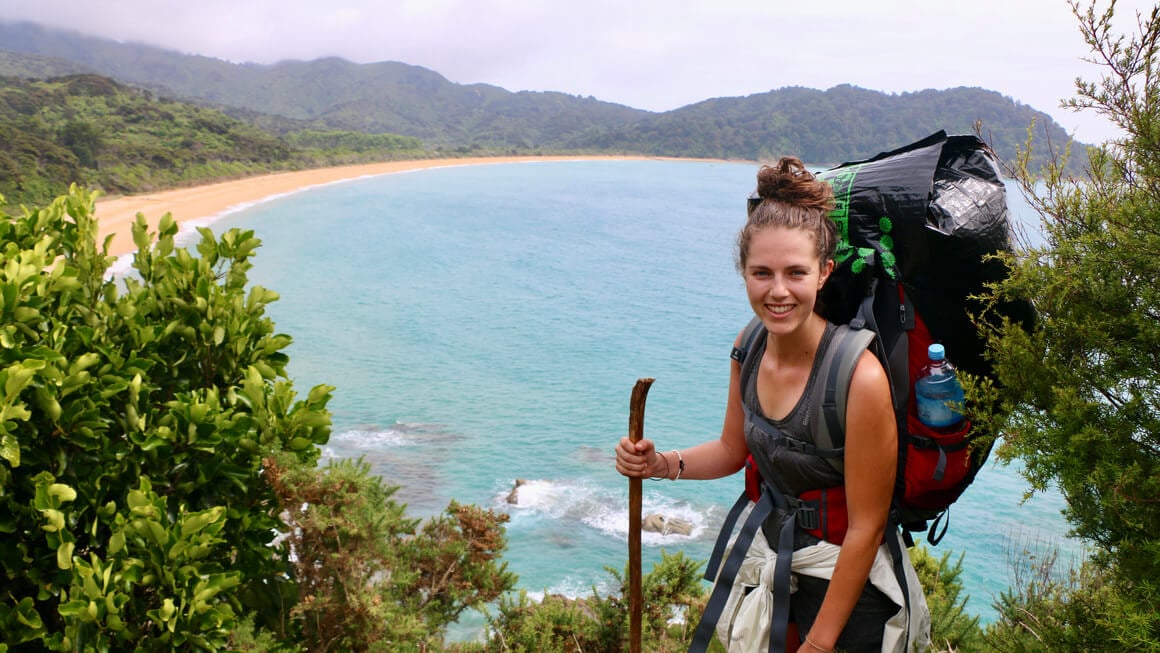
Photo: @danielle_wyatt
As you leave Nelson, the port-city-turned-tourist-hub vibe fades away. The Motueka Valley and beyond brings the good sort of ferals to the fore. There is also heeeeaps of farm work around these parts – so you can score yourself a pretty sweet travelling job.
It doesn’t take long to find the snow on the South Island. Simply head into the Nelson Lakes and you’ve got some delicious snowy peaks crying out to be hiked. Or, head down to Kaikoura if you want to see sperm whales and snow-capped mountains. The Mount Fyfe hike and hut near Kaikoura is particularly spectacular and not a very difficult one.
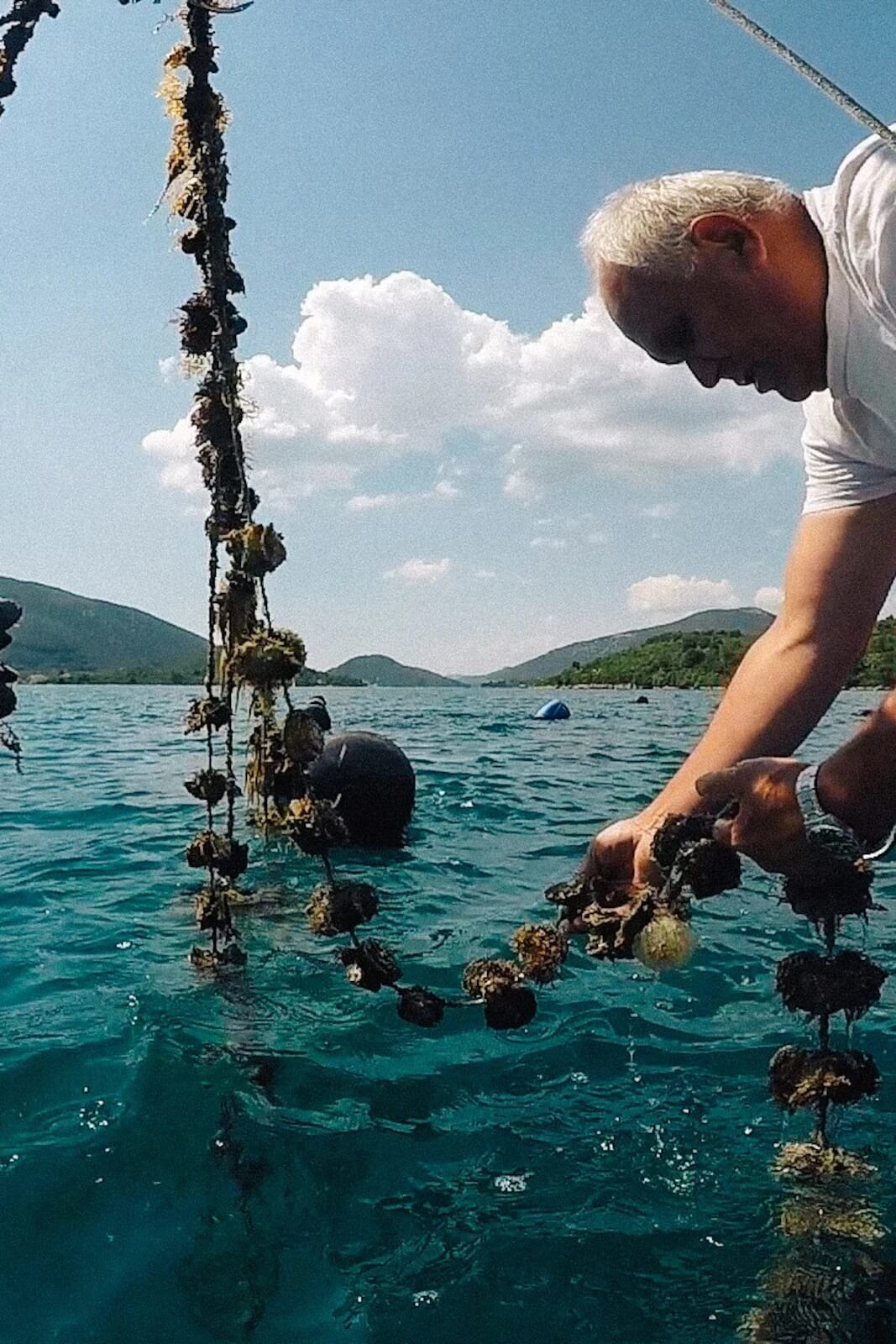
The further south you go, the more narrow the roads get and the fewer people you see. With the exception of Christchurch and Dunedin, the South Island is exclusively two-lane highways. You can expect a fair few “country road” drivers. By that I mean, Kiwis who seem to have unwavering faith in the Road Gods and tempt fate by fanging it around blind corners at 80+ kilometres per hour.
Queenstown and Wanaka throw remarkable mountains at you – as well as rock climbing, paragliding, and all manner of adventure sports. Visiting Queenstown feels a little too much like a resort town for me, but it does have a little of all the best outdoor adventures!
Wanaka is a funkier place full of quirky places to stay! It suits the dirtbag mountain lover well!
And by the time you get down to Bluff, you feel like you’ve arrived at the bottom of the world.
But hey, Bluff oysters! The best damn oysters in the world.
What to Know Before Visiting South Island, New Zealand
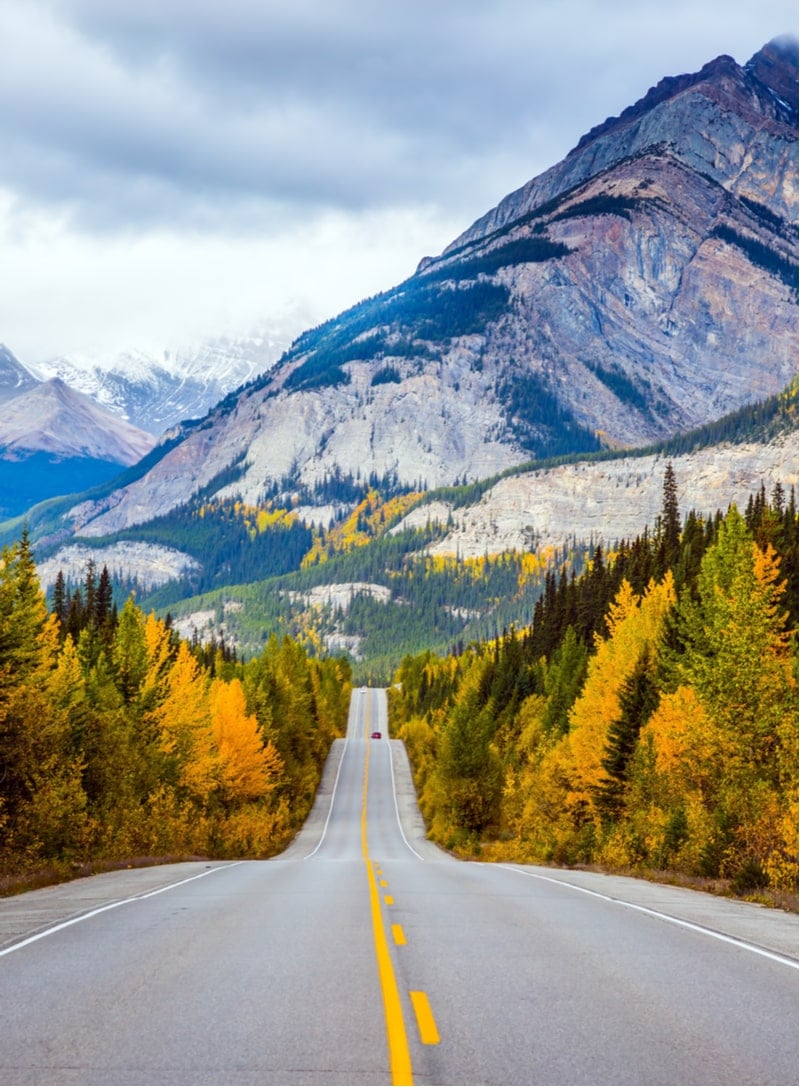
- Don’t miss out on…a West Coast road trip. Everything emblematic of New Zealand is found here. Pounamu (the greenstones Kiwis gift each other), dense jungles full of ferns, small towns, wild weather. On a good day though, you suddenly get it. This is why we love New Zealand.
- You know what’s overrated…Franz Josef. Don’t get me wrong, it’s a nice glacier and all that. But there are a lot of glaciers and a lot of epic outdoor shit in New Zealand that doesn’t have the inflated price tag.
- The coolest hostel is… The Palace Backpackers Nelson. It runs a little on the batshit crazy side, but it’s cosy and centrally located. Plus, there’s an incredible garden and chickens, so you know you’re in for a good time at the Palace.
- The best food is found in… Bluff. Specifically, Bluff oysters. There is not much going on in Bluff, but damn if their oysters don’t bring you just a little closer to God.
Backpacking the Cook Islands
The Cook Islands are a popular vacation spot for New Zealanders – but also increasingly with backpackers.
It’s easy to see why – backpacking the Cook Islands is an affordable slice of paradise! Rarotonga (the main island) has a couple of hostels, epic markets, and many surf spots! It is also a great diving location.
Those living the boat life are going to have a better chance at seeing more of the islands – including ones like Palmerston Atoll that can only be reached by sea. But even the sailor can’t see every island in the 2 million square kilometres EEZ! You’re better off picking a couple of your favourite islands and exploring them fully.

Aitutaki is one of these islands. The main drawcard is a lazy day on a white sand beach. The island is surrounded by barrier reefs – so you can walk from shore in snorkel gear and say hello to the fishies! There is some awesome fishing for bonefish and giant trevally – it’s well worth going out with a local guide so you can find the best spots.
You can hike across the whole island of Rarotonga in one day. This is a nice humble brag for when you get home: “You know I’ve walked across a tropical island in one day?”
Also, Cook Islanders are known for being some of the friendliest people! You are sure to be pulled into many conversations as you make your way about the islands. This kind of slow travel is extremely rewarding.
What to Know Before Visiting the Cook Islands

- Don’t miss out on…a big plate of Ika Mata. Fresh fish ‘cooked’ in lime and mixed up with coconut. Mmmm, heaven in my mouth.
- You know what’s overrated… it’s cliche maybe, but I don’t think anything in the Cook Islands is overrated. It’s so far removed from any experience you’ll ever have that the whole damn whirlwind is a good time!
- The coolest hostel is… Backpacker International Rarotonga. To be fair, there aren’t a lot of hostel options in the Cook Islands, but this one nails it on the head. It’s affordable, central, and full of friendly faces!
- The best food is found in… the ocean. You should be mindful of the ethics of animal tourism, but a nuanced approach to such ethics means entertaining the idea of providing food for yourself. And the ocean here can do that.
Alrighty folks, if you want to eat fresh fish in the Pacific, I’ve got to give y’all a heads up on Ciguatera.
This tiny, wee toxin called Ciguatoxin is originally produced by a microscopic algal species. It grows on and around coral reefs which are eaten by small reef fish which are eaten by larger reef fish. The toxin doesn’t break down upon digestion.
It is classed as a food poison, and if you’re anything like baby Indi, you’ll be like ha food poisoning! I’ve got guts of steel, mate – bring it on!
Yeah, nah. It’s like the worst ayahuasca trip. All vomiting, diarrhoea, and neurological symptoms and no spiritual enlightenment. There’s no cure, just pure pain. It’s coming out of both ends and the hot weather now feels like the arctic. You’ll be hallucinating and the only thing in your visions? A chorus of laughing monkeys. Little baby Indi though she could avoid poisoning? HA – never!
So, you’ve been warned. Reef fish in the tropics and subtropics will likely have ciguatera. And it isn’t a good time. So stick to pelagic species and listen to local advice!
Backpacking French Polynesia
Whether you wash up as some boat bum crewing a sailboat, or whether you fly in and do some good old fashioned backpacking, French Polynesia will leave a big sandy footprint on your heart.
The Pacific culture is strong here – in the people and in the landscape. If you have already travelled to New Zealand, you may find yourself a little confused when hiking in French Polynesia: is this New Zealand? The ferns look so similar. Quickly, you will look to the sky. No, it can’t be New Zealand – the sun is out and it isn’t windy enough to knock over a sheep. Besides, there are no sheep!
If you backpack French Polynesia, in order to stick to some kind of budget your best bet is to pick two or three islands and spend your time there. Slowing down is what island life is all about, after all…

The sailor and the backpacker will both inevitably spend time in Tahiti. Tahiti has a little more traffic than you’d expect in the Pacific, but it retains the remote and welcoming spirit of Oceania. Some of the best surf breaks in the world – like Teahupoo – are found in Tahiti. Bring a couple of extra boards, because this swell is frothing.
In a country made for beach bums, you can expect the diving to be epic too. Of course, you’d be right! The Tuamotus are the ‘middle’ group of islands in French Polynesia, home to the largest congregation of grey nurse sharks in the world. Expect to see manta rays, sea turtles, highways of reef fish – and to do it all in no wetsuit (or a very thin one)!
If you are committed to boat life, then you will likely arrive in French Polynesia via the Marquesas after sailing across the Pacific Ocean. The Marquesas are the most northern group of islands in French Polynesia. They’re monstrous volcanic towers of green jungle that harbour secret waterfalls (and cheeky pig hunts).
What to Know Before Visiting French Polynesia

- Don’t miss out on… freediving in the Tuatmotus. Whether you go with a tour out of Fakarava (one of the main islands) or meet a travel buddy along the way, there is something sublime about taking a breath and heading as deep as you can.
- You know what’s overrated…Bora Bora. There are clearer waters and nicer reefs elsewhere in French Polynesia – and they don’t cost three million dollars to go to.
- The coolest hostel is… Mahana Lodge Hostel & Backpackers. This is a chill little place tucked away with Papeete. It’s the perfect first port of call when arriving on the island and figuring out where you want to go. When it comes to places to stay in French Polynesia, there are few low-budget options, unfortunately.
- The best food is found in… Papeete, Tahiti. The markets here a full of life and a welcome sight after the slim pickings found on some of the outer islands! I’ve never been quite so happy to see a supermarket than after three months without one.
Backpacking Fiji
Fiji is probably the most suited place in Oceania for backpacking. It is frequently featured on round the world tickets – and there are cheap flights from Australia and New Zealand. Of course, it is beautiful. However, it is also cheap and relatively easy to get around. This makes it ideal for us backpackers!
If you fly into Fiji, you will likely spend most of your time on Viti Levu and Vanua Levu – the main islands. There are ferries between these two islands as well as to some of the other star favourites like the Yasawa Islands.
The Yasawa Islands were not open to tourists until the 1980s. They still have a very untouched feel to them – and very friendly locals! Everyone will find it necessary to ask you 27 questions, and if you are married and would you like to be, and so on. 😉 The Yasawa Islands feature in all of the best Fiji itineraries!

Some of the most popular things to do in Fiji are unsurprisingly water sports. There are dreamy surf breaks and amazing soft coral scuba diving sights to explore. Learning to spearfish is also very popular – and goddamn amazing!
Tourists are very safe in Fiji – although you should always keep an eye on your belongings in cities (even cities in a tropical paradise). However, Fiji is one of those places where you realise that people are complicated – and at times violent – no matter how pretty their backyard is.
There have been a few military coups over the last few decades. These came about due to rising tension between the Indigenous Fijians, and the descendants of indentured Indian labourers. Turns out British colonialism has long-reaching tentacles that corrupt the palm trees, coral reefs, and white sand beaches.
What to Know Before Visiting Fiji

- Don’t miss out on… Surfing Cloudbreak. This one is not for the faint hearted – but bless the Surf Gods for delivering up this epic break.
- You know what’s overrated…Suva. Fiji’s capital is honestly a little on the seedy side and doesn’t have the best weather. Of course, it’s fun for a night out, but beyond that it doesn’t really showcase the Pacific at its best.
- The coolest hostel is… Bamboo Beach Hostel, Nadi. This pumping and social hostel is located near Nadi – the better version of Suva. It’s close to everything you need while still feeling far enough away from the hustle for you to relax!
- The best food is found in…the streets! Fiji has some surprisingly good – and affordable – street food! Make sure to try the Fijian take on ceviche: kokoda.
Backpacking Tonga
Tonga is an epic destination within Oceania. The sailors that don’t go south towards Australia or New Zealand may find themselves stuck in Tongan paradise longer than they bargained for! It really is a hard place to leave.
Tongatapu is the main island, and where backpackers flying in will probably spend most of their time. On Tongatapu is the “Stonehenge of the Pacific” – Ha’amonga Trilithon. According to Tongans, the cheeky Maui (a trickster God who features in Polynesian origin stories) made this incredible structure.
One of the most amazing things to do in Tonga is to swim with humpback whales during their migration. You should definitely do your research and keep in mind whether the operator follows ethical animal tourism guidelines.
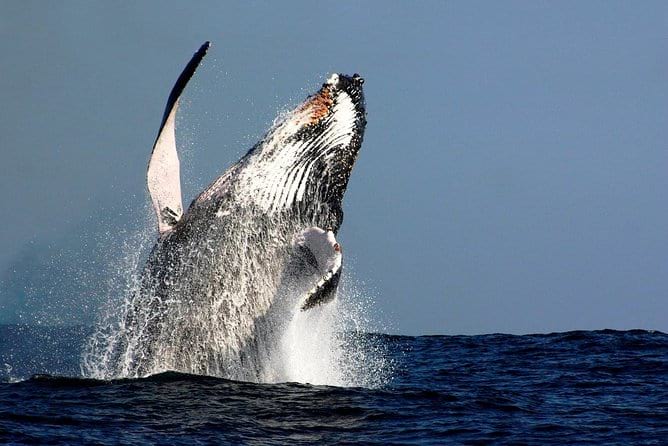
Because there are ways to ethically interact with whales. Generally, they are quite tolerant of humans. I would imagine that on account of their size comparative to ours, they don’t feel especially threatened.
Even swimming close to adult whales hasn’t been shown to have a negative impact if it is done in small numbers.
Noise pollution has been shown to alter mother and calf behaviour, so joining twenty other boats to chase down the same two whales? Probably not an ethical solution. However, sailboats and small tours don’t have the same negative impact on the whales.
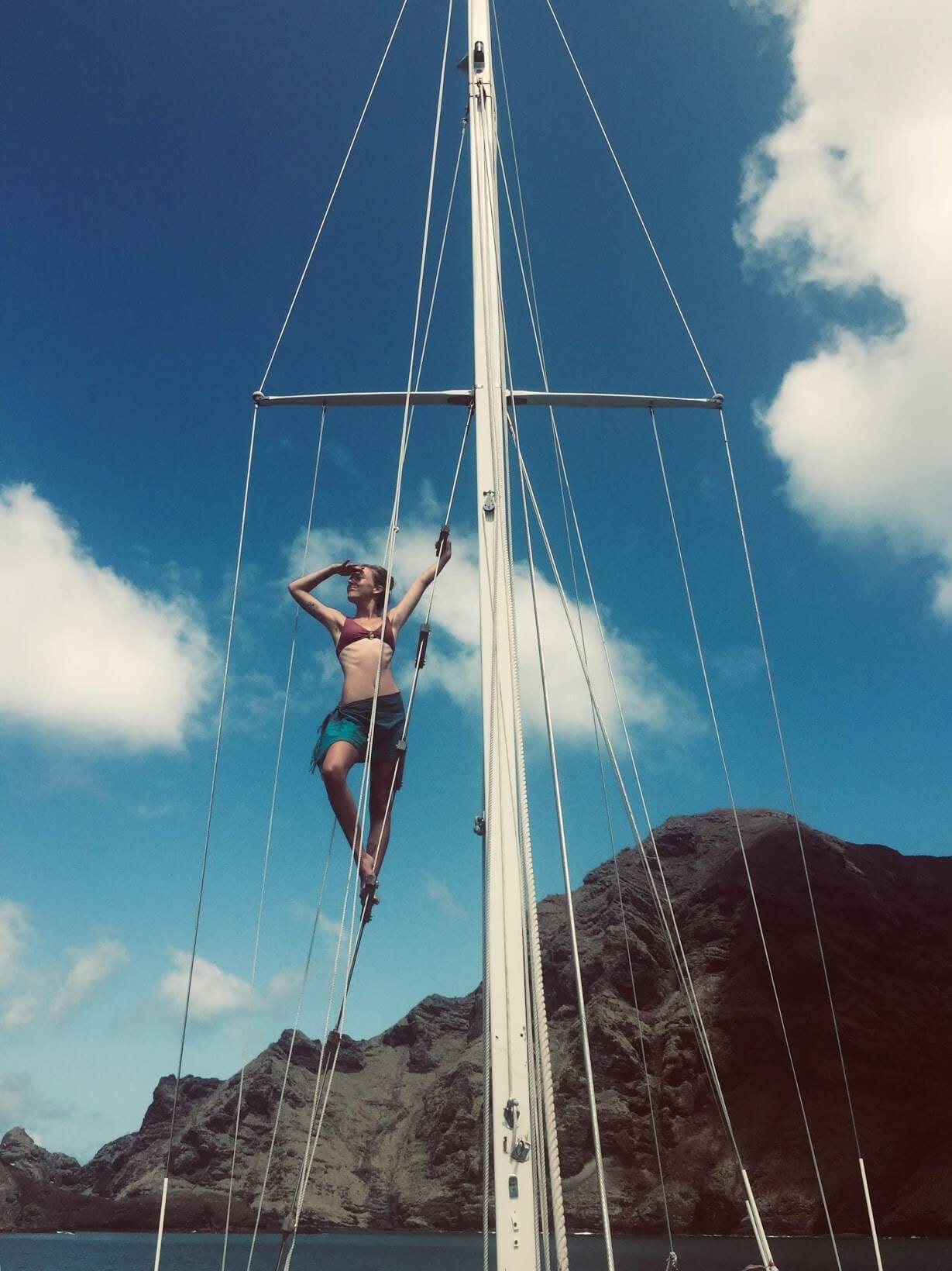
I found these extra tips to help you plan a sublime interaction with these majestic animals.
It is worth noting that the national Tongan airline does not have the best reputation. It has been (sort of jokingly) referred to as having “Death Planes”.
There are ferries between some of the main islands, but they are also known for leaving safety in the hands of a very cheeky God. Pack a seasickness bag and tip a little rum over the side of the boat to ask Neptune to keep you safe.
Living on a sailboat and being able to choose which inhibited island you want to explore eliminates this risk. 😉
Tonga was never colonised – and this is something they are rightfully proud of. It pays to be mindful about the way you conduct yourself – especially near places considered tapu (sacred). This means dressing on the conservative side and generally minding your manners a bit.
What to Know Before Visiting Tonga
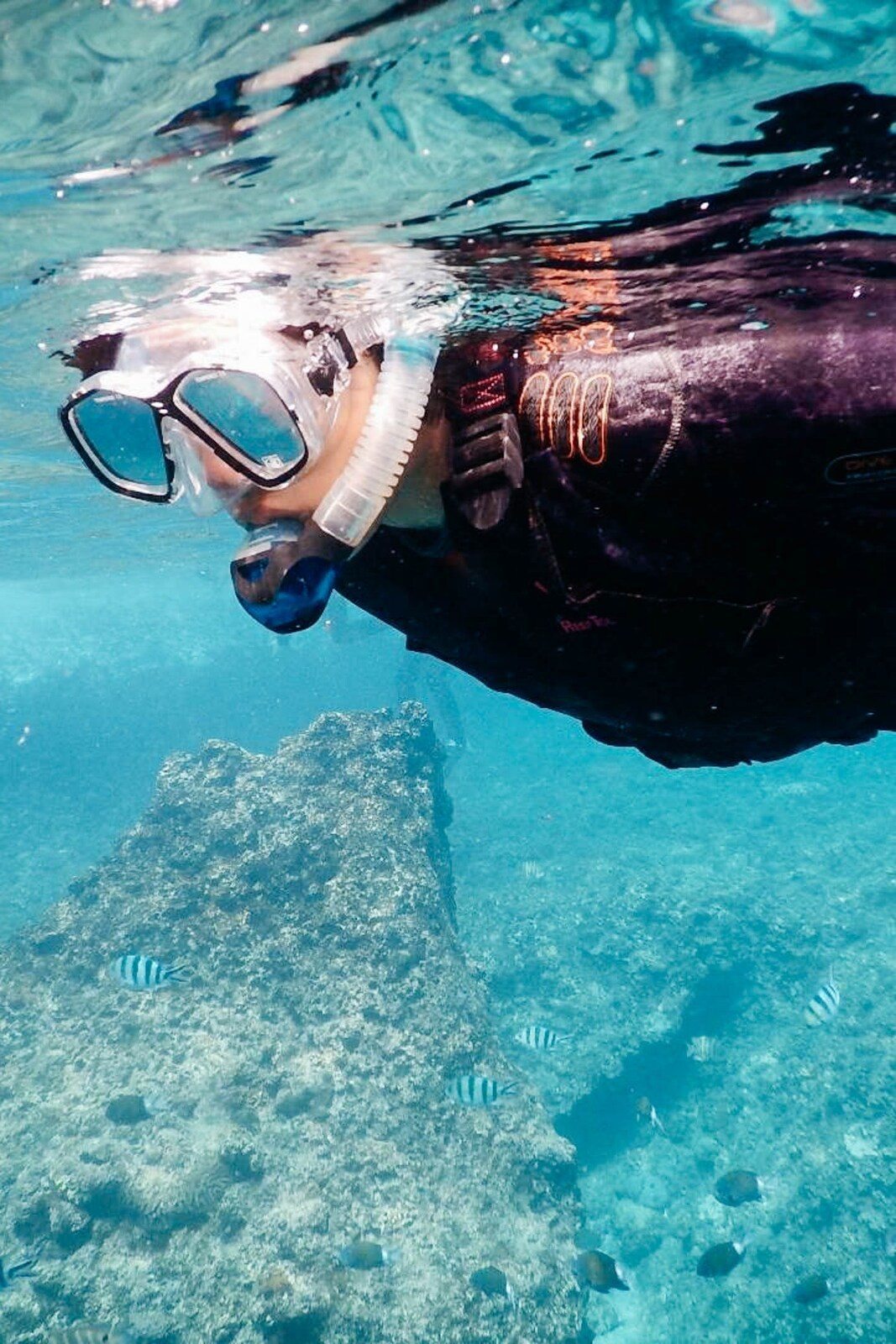
- Don’t miss out on… Mapu ‘A Vaea blowholes. It sort of feels like the Earth is angry and throwing a tantrum that involves large spouts of water – freaking EPIC!
- You know what’s overrated…flying between the islands. Maybe I’m just a chicken, but I don’t like the nickname “Death Planes”.
- The coolest hostel is… The Village Backpackers, Tonga. Super charming and full of life, this backpackers will feel like home from the moment you arrive!
- The best food is found in… the community umu. Delicious meats and vegetables are roasted in an underground oven. But more than the food, it’s the community that makes this type of meal special.
Other Stellar Pacific Destinations
Oceania has a multitude of island destinations littered across its great blue expanse. I have a bit of an obsession with Kiribati in particular.
Is it everyone’s idea of paradise? Probably not. It’s remote, often lonely, and the ‘supermarkets’ consider $7 an acceptable price for a can of beans. But the upside? Glorious, unspoiled paradise.
- Samoa. This Polynesian archipelago is full of characteristically open hearted people and jaw dropping landscapes. It is also the birthplace of tattooing.
- Vanuatu. These Melanesian islands are a mixture of subsistence living and incredible fishing with post colonial port cities.
- Solomon Islands. Wild takes on a new meaning in these stunning islands. The Soloman Islands can act as a hurricane shelter for boats crossing the Pacific.
- Papua New Guinea. Nearly 850 languages are spoken in Papua New Guinea. The cities are full of a little chaos and a lot of heart. The reefs are characteristically stunning – and the jungle and mountains remain almost impenetrable. But, as always, travel smart, use your common sense, and stay safe in Papua New Guinea.
- Kiribati. Some of the most isolated islands in the world that have some of the best fishing. They are facing an existential threat due to climate change. Depressing anecdote to add to a travel guide? Yup. But, as of yet there aren’t solid answers on how to deal with this crisis. Is it too dark to tell you to go there before they’re gone?
Getting Off the Beaten Path in Oceania
As a backpacking destination, Oceania is already quite far off the beaten path. Of course, familiar city landscapes can be found – Sydney, Melbourne, and Auckland spring to mind. But should you want to push yourself to your limits, all you have to do is leave the city!
Deserts, jungles, and mountains await the intrepid hiker. But make sure you’ve packed all the best adventure gear. Because help is a long way away out here.
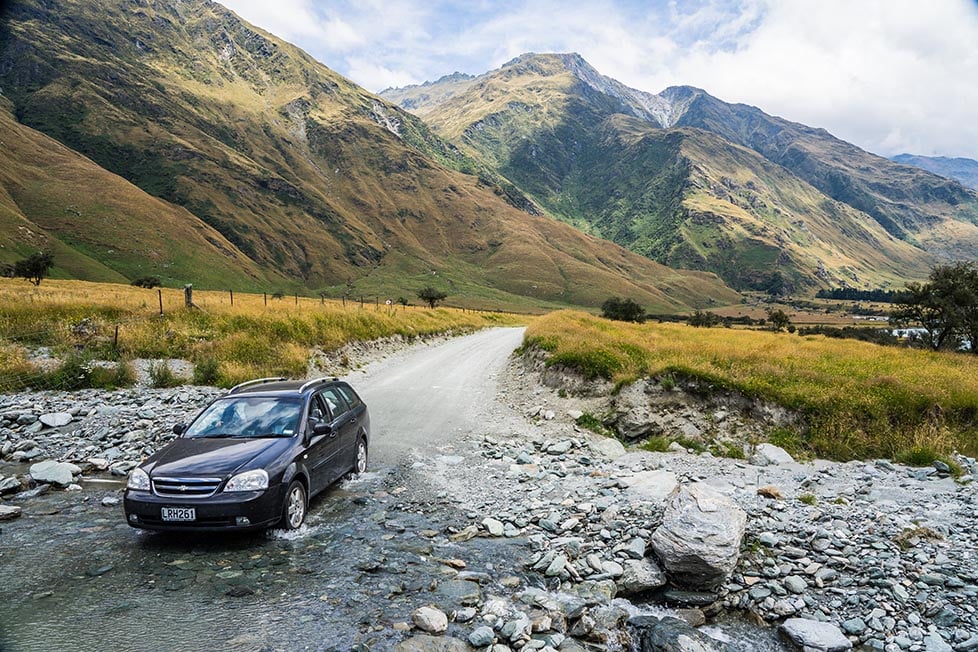
Image: Nic Hilditch-Short
If the uncharted desert of Australia and the peaks of New Zealand’s mountains prove a little too on the beaten path, you can always sail away into the Pacific. Surrendering yourself to King Neptune and washing up somewhere in the Pacific is sure to feel like the juicy off the beaten path travel that ignites personal growth.
If the populated islands of Rarotonga or Tahiti feel too easy – time to level up and explore uninhabited islands!
When backpacking Oceania, it’s easier to get off the beaten path than to stay on it!

We’ve tested countless backpacks over the years, but there’s one that has always been the best and remains the best buy for adventurers: the broke backpacker-approved Osprey Aether and Ariel series.
Want more deetz on why these packs are so damn perfect? Then read our comprehensive review for the inside scoop!
View on Osprey View on REITop Things To Do in Oceania
Backpacking Oceania conjures up images of the good life. You know, a life spent toiling away on the farm and surfing every weekend. The great outdoors is certainly the drawcard to travelling all the great gems in Oceania’s crown.
There are some truly spectacular adventures to be had: above, below, and on the water. If you want to put on a broad brim hat, paint your nose with zinc, and learn to navigate a croc-infested river crossing, then head to the Lands Down Under. Now, if the heat is too much for you… never fear! There are mountain passes galore to test yourself on.
Finding things to do in Oceania is not hard – it’s working out what you want to do first that’s the tricky part!
#1 – Scuba Diving and Snorkelling the Reefs

As you’d expect from an area that is connected by the ocean, Oceania has got some EPIC dive sites.
The Ningaloo reef off the coast of Western Australia allows you the opportunity to swim with whale sharks and over 250 species of coral! Further north is the tidal Rowley Shoals that deliver on their exhilarating drift dive potential. There is of course the Great Barrier Reef too, as well as lesser-known but equally epic dive sites like Ewen’s Pond.
The Tumakohua Pass in the Tuamotus is legendary for the large congregations of nurse sharks you see every single dive.
Diving in New Zealand is more black coral in freezing fjords, exploring sunken Russian cruise liners, and even diving on a live volcano!
You may not arrive a mermaid, but Oceania will be damned if it doesn’t turn you into one by the end of your travels.
#2 – Sailing the Swahsbuckler Life

Photo: @amandaadraper
If you enter the (somewhat shady, but definitely fun) world of sailing, you’ll find you don’t meet all that many Australian or Kiwi cruisers abroad. I think that’s because our backyard is full of such incredible sailing on our home turf. We turn our nose up just a little at doing an ocean crossing only to arrive at a more touristy version of something we have at home.
Oceania has a little bit of everything when it comes to sailing. You’ve got tropical paradises like the Whitsundays to cruise around. Or, you can take the “less people” option and vagabond the Torres Strait or the Rowley Shoals.
You’ve also got cold water paradises that range from the competitive Sydney to Hobart race; to the extremes of Stewart Island. Somewhere in between is the Bay of Islands in New Zealand.
Test Drive the Boat Life with SAILO!
Sailo is essentially the Airbnb of boats. You can charter a boat and get a taste for the high seas WITHOUT committing your savings and labour to a sailboat project.

You can get a boat and a crew who knows what the heck they’re doing, AND sample the good life boat life! There are over 30,000 boats on offer! These range from bareboat sailboats (that is, with no captain) all the way through to champagne and hot tub luxury.
Whether you want to get prepared to take on your own boat project or you want to revel in some luxury while travelling Oceania, Sailo is sure to have something for you.
#3 – Take an EPIC Road Trip

Photo: @danielle_wyatt
Oceania might be mostly ocean, but the lands were certainly made for living the van life. Driving one of the great Australian road trips will be the adventure of a lifetime.
New Zealand is made for road trips that don’t break your spirit with crushing distance. Every couple of hundred kilometres, the environment changes. Within one day you can go from the sunny beaches of Takaka, through the subtropical jungles of the Kahurangi national park, and arrive in the high country mountain pass.
None of the Pacific has very good public transport systems, so having your own vehicle means that you have a greater degree of flexibility in your itinerary as well. Be wary of the glamorous appearance of van life: it has been known to test couples and friends to their absolute limits.
Remember you are sharing a tiny space with another human for hundreds or thousands of kilometres. You’re not going to love them every second of every day – but if you can come out the other side, you’ll have an enviable and unbreakable bond. The Road is really the best teacher.
#4 – Go ‘Tramping’

This is a uniquely kiwi phrase for multi-day hikes, typically through the backcountry. Aussies are a big fan of it too, we just call it going bush.
The Pacific Islands also have their fair share of epic hikes to do as well. Nuku Hiva in French Polynesia has hidden waterfalls around almost every corner of a trail!
New Zealand has nearly 1000 huts maintained by DOC. These range from bunk beds, mattresses, fireplaces, and filtered water to a lean-to bit of tin in the middle of the mountains. The map of all these huts is pretty damn epic and is sure to inspire you take to take to one of the backcountry trails.
If you’re short on time backpacking New Zealand, I would recommend doing a tramping trip in the Nelson Lakes.
#5 – Do Some Farm Work
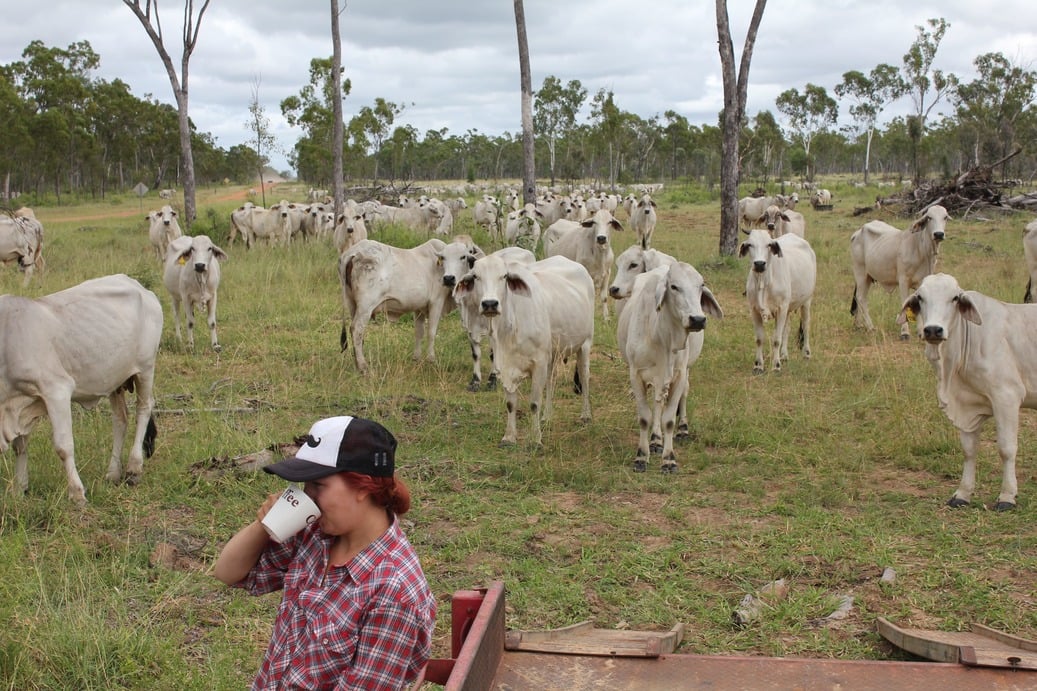
Photo: Elina Mattila
Do I have a thirty-two-minute rant about the uniquely Australian and Kiwi exploitation of migrants in the farming industry? Yes, and as you can tell, I’m extremely popular at parties.
However, farm work is something of a rite of passage for backpackers in both Australia and New Zealand. Whether it’s volunteering through a Workaway-style site or just working for your dollaridoos, you’ll probably end up working shoulder to shoulder with people from other Pacific Islands who somehow have even fewer rights than backpackers on the farms.
Anyway, it can be a really good way to save money and experience the countryside of Oceania in a way that you wouldn’t be able to otherwise. Plus, you’ll walk away knowing that ‘unskilled’ labour is a misnomer. There is a skill – nay, an art – to harvesting fruit and maintaining a farm!
#6 – Doof ’til You Drop!

Photo: @themanwiththetinyguitar
Ok, so what’s a doof? A doof is a psytrance festival (but featuring other genres if it’s not a shit doof). There will be wubs, there shall be dubs, and you can bet yo’ bottom dolla there’ll be duggas!
If you’ve doofed anywhere on the planet, you know the vibes. It’s hippy goodness: cuddles, ketamine, and a fun game called ‘Crack a Nang Every Time Someone Says “Everything happens for a reason”‘.
Look, a doof is something better experienced than spelled out to you. Find a good crew of good humans, take plenty of water, and go hard. You’ll either get it or you won’t, but if you’re looking for community and connection while backpacking Australia, well… there are still some things hippies get right. 😉
#7 – Eat a Baguette (and marvel at weird French bread laws)

Wherever you arrive in French Polynesia, you are sure to be able to buy fresh baguettes for less than one euro. Travelling in this part of Oceania feels more than a world away from Europe. There are volcanic islands, mahi-mahi, and fresh mangoes that roll down the street.
And yet, come lunchtime even the gendarme closes and everyone eats their bread. The French take their bread very seriously – and so, now, do the French Polynesians.
A baguette in French Polynesia must be:
- 50 – 60 cm
- Weigh at least 250 grams
- Cost no more than 53 Pacific Francs (50 US cents).
French bread in a tropical paradise – not too shabby!
#8 – Drink Kava

Allegedly Fijian kava is the best kava – although other Pacific Islands may have my head for that. Kava itself is either a drink or some kind of extract from the roots of Piper Methysticum – a plant common throughout the Pacific.
When you consume it, you experience a cross between being tipsy on two glasses of champagne and a microdose of mushrooms. It is technically a depressant, so it can be quite relaxing. It has been known to have mild hallucinogenic effects too, although I never experienced any hallucinations.
In the Pacific Islands, it is often used ceremonially, so it pays to be culturally sensitive (and also not take more than you can handle). Chucking your guts up because you thought you could handle another “high tide” cup of kava is not the best look!
#9 – Collect a Sighting of Each National Animal

Photo: Alexandria Zboyovski
Oceania is home to some truly weird and ADORABLE critters. Playing spot the Australian animal is a bit like Pokemon sightings. Some are abundant – kangaroos are honestly bloody everywhere – and some are very rare (like Gilbert’s Potoroo).
The national animal of New Zealand is the kiwi. Your best bet for a sighting is to head down south to Stewart Island. DOC is also paying people to report any and all sightings of the kokako bird which may or may not be extinct.
I will be that parent who takes their kids to French Polynesia and has them identify coral and fish species with me. I mean, I know it will mostly be me getting really excited at the high biomass of fish concentrated in one reef while my kids show me mercy and humour my interests.
Still, families travelling to the Pacific can enjoy keeping an eye out for the Pacific Fruit bat. And once you go snorkelling, there’s no getting around the majestic sea turtles you’re likely to encounter!

Wanna know how to pack like a pro? Well for a start you need the right gear….
These are packing cubes for the globetrotters and compression sacks for the real adventurers – these babies are a traveller’s best kept secret. They organise yo’ packing and minimise volume too so you can pack MORE.
Or, y’know… you can stick to just chucking it all in your backpack…
Get Yours Here Read Our ReviewBackpacker Accommodation in Oceania
There is a range of backpacker accommodation in Oceania. In Australia and New Zealand, there are many hostels that are cheap and funky places to hang out. You’re bound to meet a new travel buddy!
Rarotonga (Cook Islands) and Tahiti (French Polynesia) both have a couple of hostel options. Suva in Fiji also has some hostel options. But outside of the main centres, there are very few backpacker hostels.
Even within Australia and New Zealand, hostels are not always the preferred option. They can be quite expensive!
The big reason to hunker down in a hostel in Oceania is to save some all-important cash while on the road. As this is an expensive part of the world, you can expect that everyone at the hostel is in the same broke boat as you. There’s a bit of hostel etiquette that goes a long way to having a good stay!
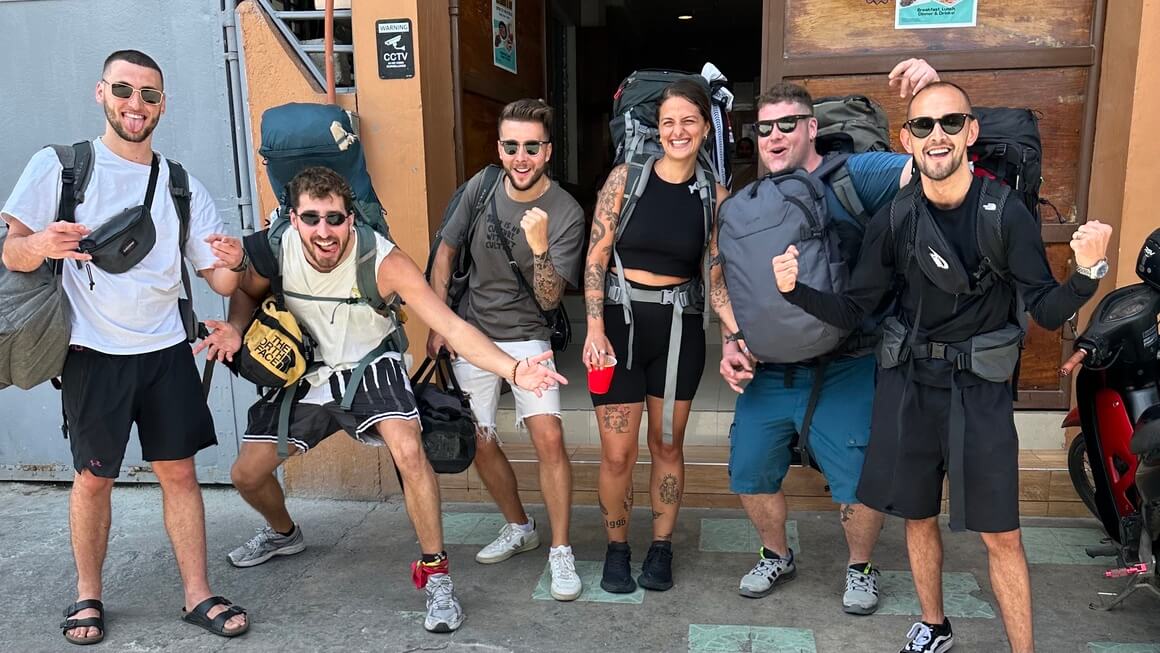
Photo: @joemiddlehurst
Having your own transport – be it a boat or van – that doubles as accommodation is very useful while travelling Oceania. Having a good tent also allows you to take advantage of much of Oceania that was simply meant to be camped in.
Of course, littered throughout the Pacific are some truly stunning Airbnbs that make for an amazing getaway! Sometimes you need a vacation from your vacation.
However, my preferred way to stay in Oceania is in my tent. If you’ve got a solid backpacking tent and some good quality gear, you can see the great outdoors the right way.
Oceania Backpacking Costs
There’s no sugar-coating it – Oceania is pretty expensive. However, there are still the tried and true methods of budget backpacking that will help get you through!
Australia and New Zealand both come with wages and the shockingly high cost of living to accompany them. It’s not unreasonable to live on a budget of <$30/day, but the lower you go, the more you’ll be eating from dumpsters and shirking material comforts in order to lower your travel costs. Australia and New Zealand are also good places for many people to get work visas and save coins in.
The Pacific Islands are a mixed bag. Where there is some tourist infrastructure – like Fiji and Tonga – usually there follows with cheaper prices. You could budget $30 – $50/day and live VERY comfortably. Across the Pacific, the biggest cost is usually accommodation. If you camp, or sail in and anchor more than your moor, you will save a lot.
It’s just a balancing act. A little dirtbaggery and a little hard work and then backpacking Oceania can become very affordable.
A Daily Budget in Oceania
| Country | Dorm Bed | Local Meal | Bus/Train Ride (three hours or less) | Average Daily Costs |
|---|---|---|---|---|
| Australia | $20-$35 | $10-$20 | $30 | $50-$60 |
| New Zealand | $20-$30 | $10-$20 | $20 | $40-$50 |
| French Polynesia | $30 | $10+ | $10* Only available on Papeete | $50 |
| Cook Islands | $25 - $35 | $10+ | $16 day pass* Only available on Rarotonga | $40+ |
| Fiji | $10 - $25 | $5-$10 | $15 | $30-$40 |
| Tonga | $15 - $30 | $10+ | Less than $5* only available on Tongatapu and Vava'u. May not ever be on time | $30+ |
Travel Tips – Oceania on a Budget
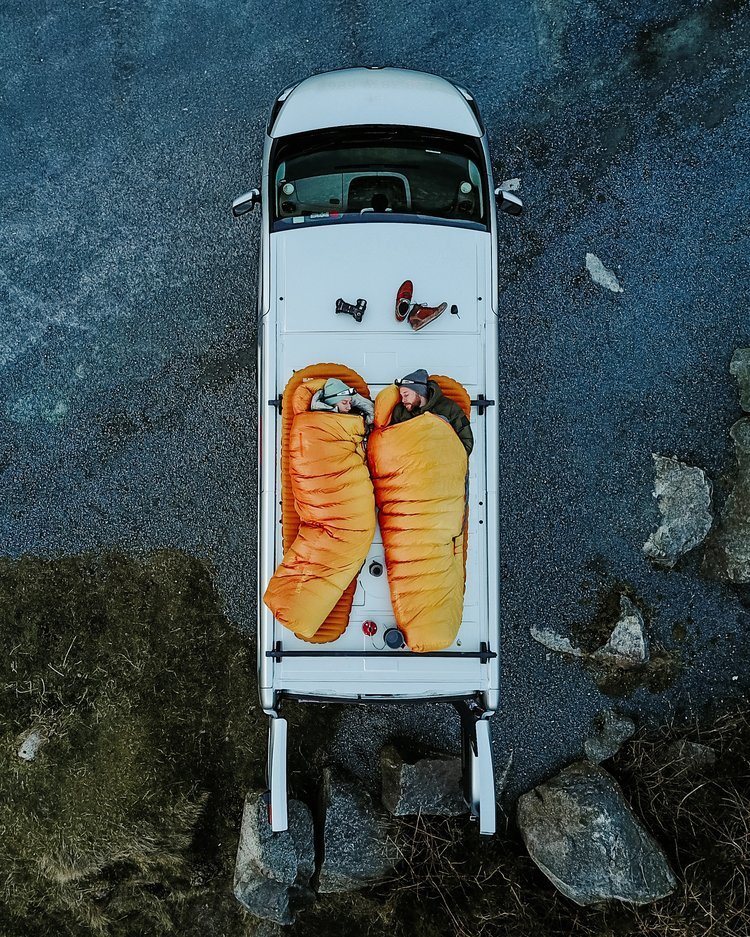
Photo: Kyle Murphy
- Go camping. Having a good tent and camping gear can open up all kinds of nooks and crannies to sleep in. Apart from the sublime beauty of sleeping bush – you can save some serious coin by camping too.
- Cook your own food. Once you’re hooked up with a good camping stove, you can keep an eye out for cheap food deals and make food yourself! Eating out is notoriously expensive in Australia and New Zealand – although, in the Cook Islands, it often ends up cheaper to eat out than cook for yourself.
- Hitchhiking. Stick out your thumb and go on a hitchhiking adventure! In many of the Pacific Islands, hitchhiking is simply the most accepted and convenient way of getting around. And not only do you save a little money, but you open yourself up to the adventure of a lifetime. Only hitchhiking will you meet an ex-circus performer in the morning and a reformed drug dealer turned youth outreach worker in the afternoon.
- Get a van – Legit. Laugh defiantly in the criminally high accommodation prices in Australia and New Zealand. Cry at the criminally high fuel prices. Sleep somewhere beautiful.
- Drink the tap water – Fair dinkum I see a lot of tourists buying bottled water. The plastic debate aside, you’re just being daft – the water’s delish! (Except in Adelaide.)
Why You Should Travel to Oceania with a Water Bottle
Plastic washes up on even the most pristine beaches… so do your part and keep the Big Blue beautiful!
You aren’t going to save the world overnight, but you might as well be part of the solution and not the problem. When you travel to some of the world’s most remote places, you come to realise the full extent of the plastic problem. And I hope you become more inspired to continue being a responsible traveller.
Plus, now you won’t be buying overpriced bottles of water from the supermarkets either! Travel with a filtered water bottle instead and never waste a cent nor a turtle’s life again.

Drink water from ANYWHERE. The Grayl Geopress is the worlds leading filtered water bottle protecting you from all manner of waterborne nasties.
Single-use plastic bottles are a MASSIVE threat to marine life. Be a part of the solution and travel with a filter water bottle. Save money and the environment!
We’ve tested the Geopress rigorously from the icy heights of Pakistan to the tropical jungles of Bali, and can confirm: it’s the best water bottle you’ll ever buy!
View on REI Read the ReviewBest Time to Travel to Oceania
Oceania is a big area, and so there are regional variations in the best time of year to go and visit. There is a huge variation in latitudes which means you get a huge variation in seasons and weather.
It also means that, if you play your cards right, you can end up travelling in an eternal summer!
Generally speaking, New Zealand is more pleasant to visit in the summer months of November to March. The same goes for Australia under the latitudes of 25 – 30 degrees south (think south of Brisbane) and in coastal areas. The desert is a bit different, and the jungles and the north are different again.
Throughout the Pacific, there is an optimum time to avoid hurricanes, but you can expect warm weather year-round. Generally, you want to travel in the Pacific between March and September.
Best Months to Travel: May – October (dry season)
What’s the climate of North Australia like? This is equatorial tropics through and through. In wet season you can’t go outside without immediately becoming wet. Whether it’s your own sweat or the rain becomes an irrelevant distinction.
Personally, I love the warm hug of the tropics. I always feel like I’m home the moment I step off into the warm embrace of humidity. But, I know most people feel like they are being breathed on by a rabid dog in humidity, so your best bet is to travel during dry season.
Best Months to Travel: June – September (the Aussie winter)
What’s the climate of Outback Desert Australia like? Like a desert, mate. Sorry you can take the Australian out of the sarcastic country but you can’t take the sarcasm out of the country Australian.
In all seriousness, if you go to the outback in summer it will be 40+ degrees. For the uninitiated I’ve been told this feels like hell.
In winter, you will be able to enjoy the outdoors more – and that’s the whole point of going to the desert, right? Be sure to bring layers on layers because the desert winter can get cold.
Best Months to Travel: September – May (the Aussie spring and summer)
What’s the climate of South Australia like? South Australia is a state but (shh) no one cares about them. Here I’m referring to the coasts that are south of the tropics and out of the desert.
It ranges a fair bit from subtropical to mediterranean. But you can expect blue skies and beach weather if you come during summer! There isn’t too much rain on the cards – just keep an eye on the bushfires.
Best Months to Travel: November – May (NZ/Aus summer)
What’s the climate of New Zealand and Tasmania like? Cold. Blustery and cold. I remember flying into Wellington in November in a singlet and shorts expecting the beginning of summer to be underway like it was back in Australia.
Gale force winds, an emergency landing, and drizzle welcomed me instead.
Oh boy, I’m not selling it am I? Ignore my sooky butt – the summer of NZ and Tasmania is beautiful. The skies are clear and if you ignore the wind, it’s warm too! And how do you get epic snow capped mountains if you don’t have a little cold and rain? No omelette without eggs.
If you are from a warmer climate, I’d suggest packing a good jumper even in the summer time here though.
Best Months to Travel: March – November
What’s the climate of Polynesia like? It is equatorial with a side of hurricane. If you avoid hurricane season, you don’t need to expect much rain or humidity.
It is usually clear skied and pleasantly warm – although around the equator you can expect a fair bit of humidity year-round.
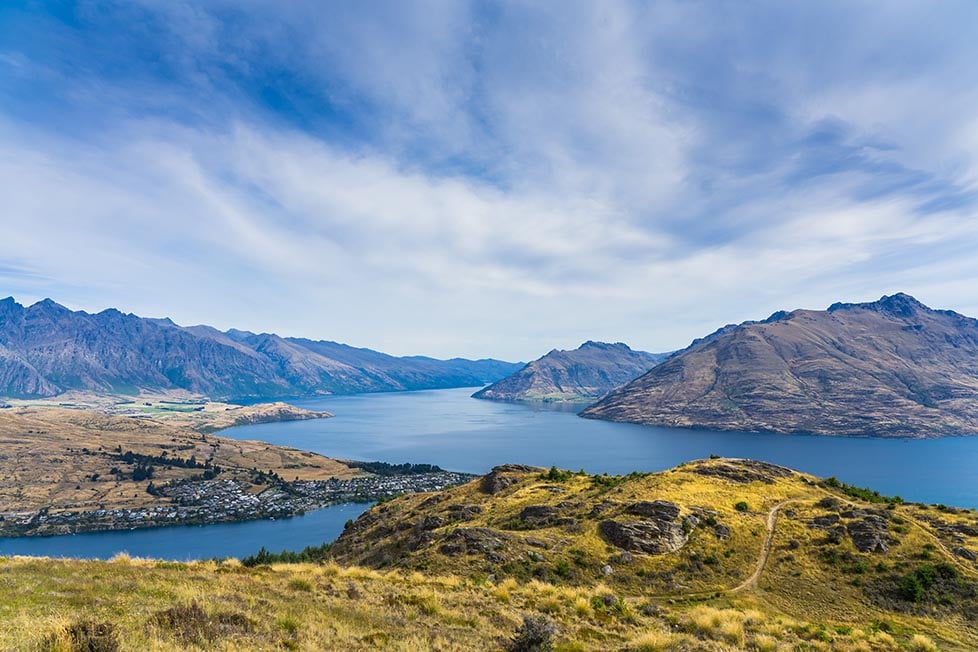
Image: Nic Hilditch-Short
What to Pack for Oceania
For such a variety of climates and range of activities to be done while backpacking Oceania, you will need the ultimate packing list.
There is no need to be that guy who carts around 50 kilos of luggage. But you don’t want to be without the essentials either!

Osprey Aether 70L Backpack
Ya can’t go backpacking anywhere without a blasted backpack! Words cannot describe what a friend the Osprey Aether has been to The Broke Backpacker on the road. It’s had a long and illustrious career; Ospreys don’t go down easily.
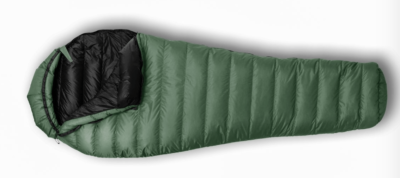
Feathered Friends Swift 20 YF
My philosophy is that with an EPIC sleeping bag, you can sleep anywhere. A tent is a nice bonus, but a real sleek sleeping bag means you can roll out anywhere in a and stay warm in a pinch. And the Feathered Friends Swift bag is about as premium as it gets.
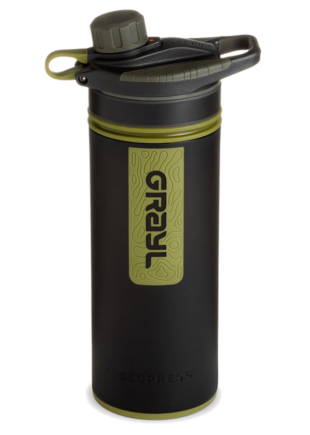
Grayl Geopress Filtered Bottle
Always travel with a water bottle! They save you money and reduce your plastic footprint on our planet. The Grayl Geopress acts as a purifier AND temperature regulator – so you can enjoy a cold red bull, or a hot coffee, no matter where you are.

Petzl Actik Core Headlamp
Every traveller should have a head torch! A decent head torch could save your life. When you’re camping, hiking, or even if the power just went out, a top-quality headlamp is a MUST. The Petzl Actik Core is an awesome piece of kit because it’s USB chargeable—batteries begone!

First Aid Kit
Never go off the beaten track (or even on it) without your first aid kit! Cuts, bruises, scrapes, third-degree sunburn: a first aid kit will be able to handle most of these minor situations.
Staying Safe in Oceania
Oceania consistently has one of the lowest crime rates in the world. Must be the sunshine or the livable minimum wage or something.
Nah, people are people no matter where you go. I’ve had my car broken into in New Zealand, and I’ve seen drunken fights in every country – even in paradisiacal French Polynesia. So it pays to heed general on the road safety tips.
But, the wildlife and awesome force of nature do warrant a word of warning. Travelling through Oceania can be unpredictable.
Australia is known for its spiders, snakes, and crocodiles but it’s the sun that causes cancer and dehydration that will get you in the desert. Hiking in New Zealand’s backcountry has done many an experienced adventurer. Despite the lower altitudes of some of the mountains, the latitude of the whole country and the unpredictability of its weather systems mean you can get caught out.

Image: Nic Hilditch-Short
And if you do take to sailing across the Pacific, despite all your preparation, you are still at the whims of Mother Moana. Keeping an eye on the weather charts is paramount to staying safe.
Being organised and prepared may not be the sexiest of travel safety tips, but it is the most practical!
Sex, Drugs, and Rock ‘n’ Roll in Oceania
The backpacker life and sexy times go together as well as socks and sandals.
Both the Australian accent and the kiwi accent have been ranked as the sexiest in the world. So, it’s fair to say you’ll probably have a certain kind of encounter with a certain kind of sexy someone. Sex on the road is known for being fleeting more often than it is permanent, so through it all let’s be kind to each other.
Free love is about love as much as it is sex, so be good to your smush buddies.
And drugs? Well, well, well. Like, everything in the Lands Down Under they are expensive. But, you can find good quality of just about anything. Certain areas are good for tracking down God-inducing mushrooms. Weed is often cheaper than alcohol and is definitely cheaper than ciggies.

Across the board, the good stuff is pretty much all illegal. So be careful who you buy from – but hey, drug dealers have just as much integrity as the Australian government at this point, so I’m not comfortable moralising about their career pathway.
Travelling and drugs go together even better than sex and the backpacker life. 😉 But the whole point of getting high is to modify your brain chemistry. Never say no to drugs (sorry mum), but drink heaps of water and look after your mates. Part of growing up as a traveller is recognising the traveller mistakes before you fall into them.
And while you’re out taming crocodiles while tripping on acid, you might want to get yourself some insurance! That way, you can still adventure to your heart’s content with the nice safety net guarantee that if something does go wrong, you’re all sorted.
Getting Insured BEFORE Visiting Oceania
Before you go travelling, please consider a good travel insurance provider. Shit happens on the road (and open ocean) all the time, and when it does, it’s nice to know somebody has got your back. And what’s the one travel insurance provider The Broke Backpacker trusts for all its insurance needs…?
World Nomads!
ALWAYS sort out your backpacker insurance before your trip. There’s plenty to choose from in that department, but a good place to start is Safety Wing.
They offer month-to-month payments, no lock-in contracts, and require absolutely no itineraries: that’s the exact kind of insurance long-term travellers and digital nomads need.
SafetyWing is cheap, easy, and admin-free: just sign up lickety-split so you can get back to it!
Click the button below to learn more about SafetyWing’s setup or read our insider review for the full tasty scoop.
How to Get Into Oceania
While some of the Pacific Islands are all about welcoming tourists, Australia (and to a lesser extent, New Zealand) has a reputation for grilling everyone who crosses its border.
You can be organised and prepared to fight the bureaucracy but sometimes it just wins. But, here are some tips as to how to win the visa game.
Entry Requirements for Oceania
Most Pacific Islands do not require a visa for tourists provided they have an onwards flight and valid passport. French Polynesia has been known to request proof of funds – including for some sailors a bond to be repaid upon departure of the country.
But for the most part, when your economy relies on tourism, tourist visas are easy to obtain. In the Cook Islands, for example, you can get 31 days visa-free upon entry and then extend your stay by 31 days at a time for a maximum of six months per year.
Australia and New Zealand are a little bit of a different kettle of fish-bureaucracy. I can only suggest doing a little research and having your visa sorted before coming to the country.
The four main types of tourist visas in Australia are:
- Visitor visa (subclass 600)
- Electronic Travel Authority Visa (ETA) (subclass 601)
- eVisitor (subclass 651)
- Working Holiday visa (subclass 417)
Your best bet to finding a visa that works for you is to head to the immigration website as visas are very nationality dependent. The working holiday visa is what many backpackers come in on. By working for a set amount of time on a farm, you can be granted a second year visa to travel and work in the country.
New Zealand has many visa options for backpackers and visitors. You can apply for a New Zealand Electronic Visa before entering the country and subsequently apply for a ‘proper’ visa once you arrive.
There is a working holiday visa that many backpackers are eligible for but it is very dependent on your age and nationality. New Zealand’s immigration website is easy to use and has good information about what visa options are available to you.


Get 15% OFF when you book through our link — and support the site you love so dearly 😉
Booking.com is quickly becoming our go-to for accommodation. From cheap hostels to stylish homestays and nice hotels, they’ve got it all!
View on Booking.comHow to Get Around Oceania
Once on the mainland of each of the countries and islands that make up Oceania, some kind of car or van is your best bet. You want to have your own vehicle as there are not great public transport options.
Getting between countries in Oceania can be done by sailboat or plane. Sailing around sounds romantic, but it does take time. You might find that a quick flight saves a lot of labour and makes for a more enjoyable trip!
Common Types of Transport in Oceania
These are the backpacker fan-favourite methods of getting around Oceania!
Keep an eye out on services like Skyscanner – there are often deals between countries in Oceania going cheap. Adding a stop in Rarotonga while backpacking in New Zealand can be done quite inexpensively if you keep an eye on flight deals.
Even if you are travelling Australia via land, sometimes a flight somewhere is the most effective use of your time and money!
It can be done! Services like Bookaway help you spot deals with overland bus travel. But for the most part, buses and trains are not well-developed services in Oceania. You are far better off having your own vehicle to allow more freedom to explore.
Having your own vehicle might sound expensive to the first time backpacker. But travelling to Oceania really cannot be done without one.
The best part about travelling with your own van is that you can usually sell it for around what you paid for it – not so expensive after all!
After having lived in Australia and New Zealand – and travelled much of the Pacific – I can confidently say that buying a 4wd is worth it. You have access to all the most pristine beaches and hardcore off the beaten path adventures!
Next time I’m in Australia I’m upgrading from a beaten up Toyota Hiace, to a well-loved Toyota Hilux.
Ah yes, the boat life. Doesn’t it sound romantic? Look, I still think sailing is the ultimate form of slow travel. It forces you to disconnect from your phone and connect with the awesome force of nature. You get to know yourself and the places you travel to extremely well.
But, they take some serious work and dedication. Your boat can only take you as far away from land as you can confidently fix it.
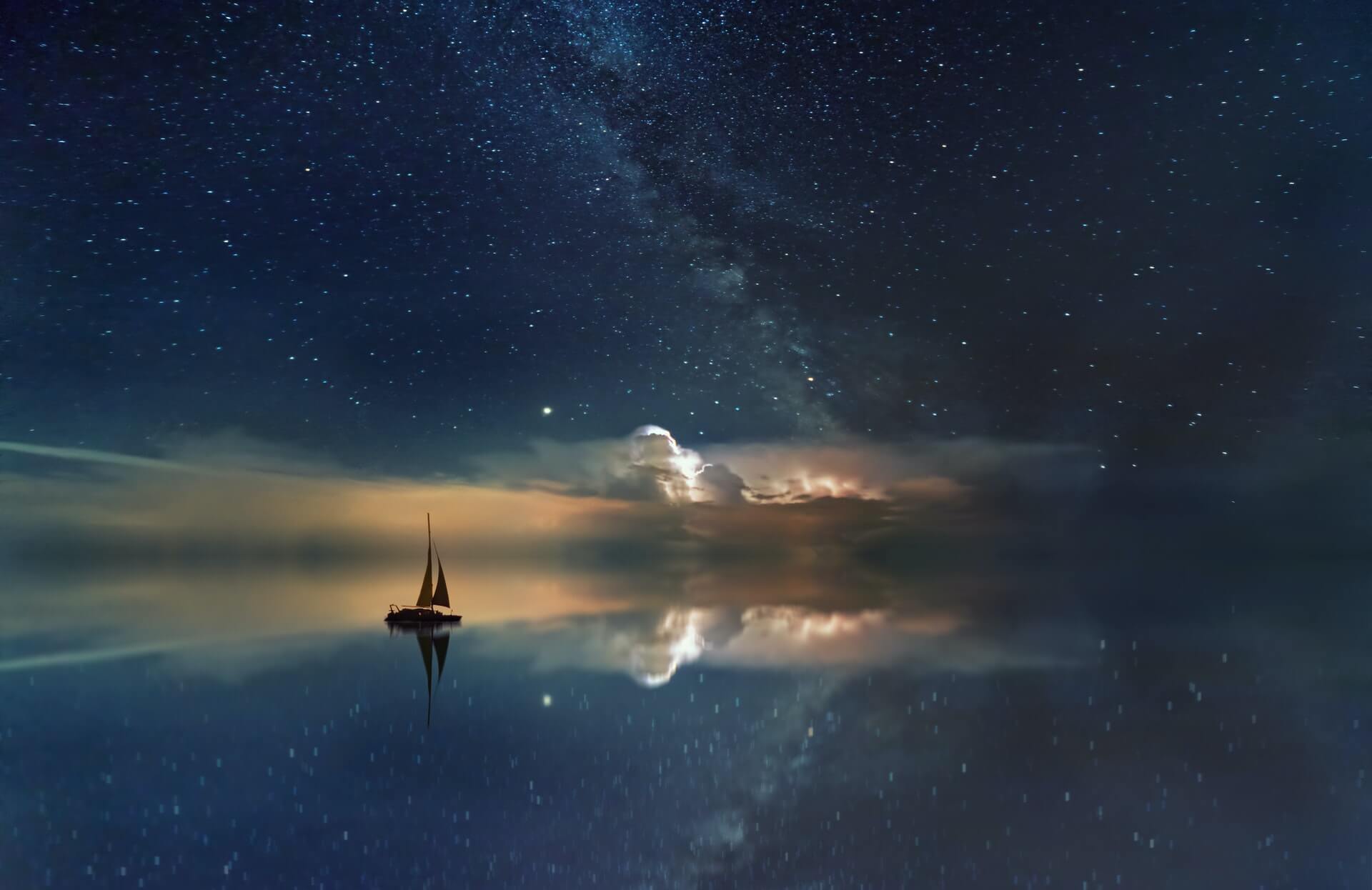
Onwards Travel from Oceania
Travelling on from Oceania is usually going to mean a plane ticket. Luckily, there are cheap flights travelling to Southeast Asia and whole new continents to explore!
It’s pretty standard for backpackers to spend some time in Australia or New Zealand working and saving before jetting off to one of Southeast Asia’s premier destinations, Thailand, Vietnam, and Cambodia, in particular. Or… Bali. (Psst – or India isn’t super far if you’re more of the seething chaos-magnet type.)
If you are committed to going around the world without flying – there is always the sailing option. Many sailors will look for extra hands (even inexperienced ones) for longer passages. Be sure to be able to cook, be clean, flexible, and follow instructions.
Sailing between Australia and New Zealand is a common passage; as is sailing from Australia to Indonesia.
Working and Volunteering in Oceania
Working holiday visas are a popular way to travel in Australia and New Zealand. They allow you to do exactly what’s in the name: work and travel. Australia in particular has a great minimum wage so it’s a great way to stack some cash for further adventures.
Working in the Pacific is less of an option. There aren’t many established industries to begin with, and no working visas to speak of. Plus, the local wages aren’t great.
Internet is a funny one in Oceania. In the cities, you can expect fast and good quality wifi or Internet to be readily available. Outside of the cities – be it rural Australia or rural Fiji – there is often no wifi and no phone service. It’s called let’s play a game and see if I can text my mum I’m safe today.
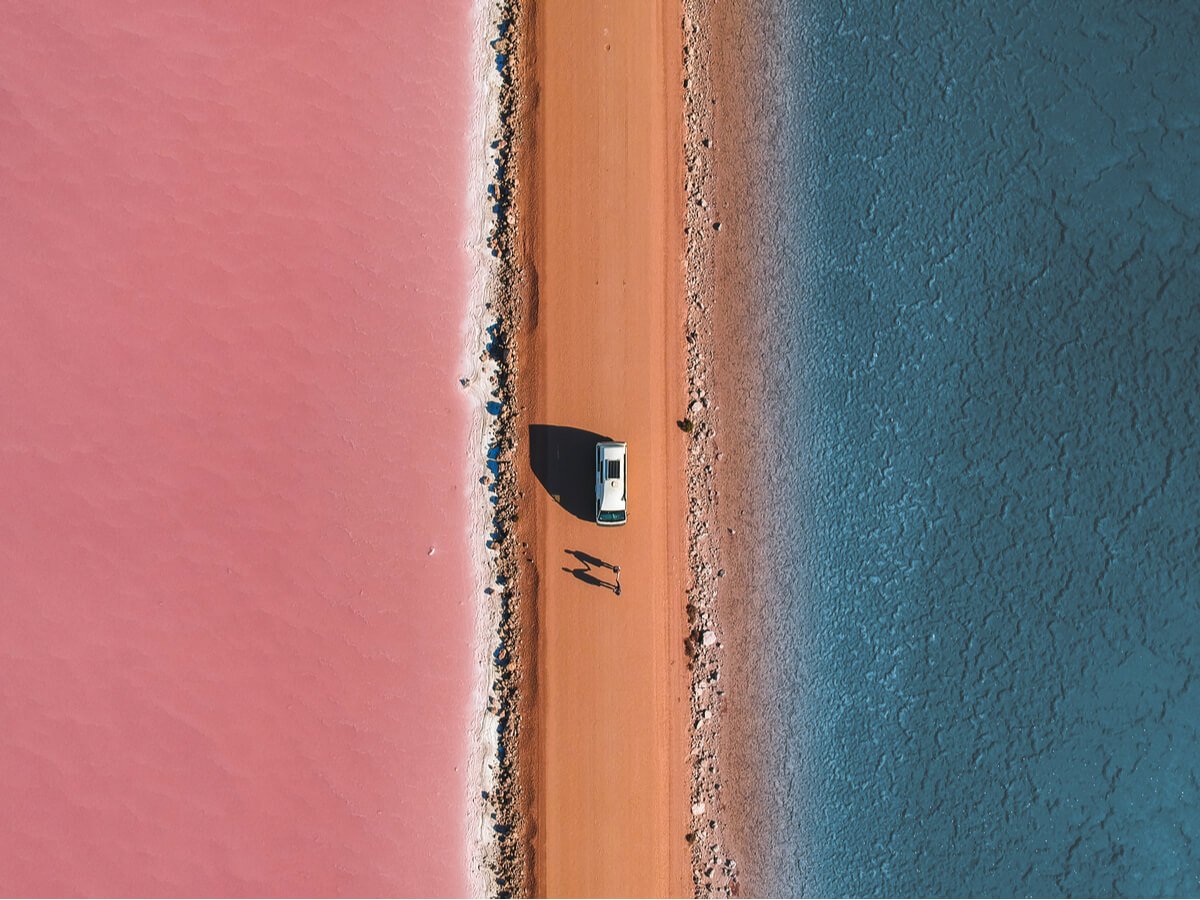
With such patchy internet services, the digital nomad scene is pretty limited. There also aren’t visas that are exactly friendly toward freelancers or digital nomads. “What do you mean you use the internet to work? That’s impossible!” That being said, as internet coverage improves, the laid back lifestyle may yet start attracting more remote workers to Oceania – though, the high cost of living will keep many away.
What Oceania does have an abundance of, is WWOOFing/volunteering! This is a super popular way to save cash in Oceania.
There are many WWOOF and Workaway type programs that allow you to volunteer some of your time in exchange for accommodation and food. Not only do you save money, but you also get to give back and do a little good.
When you slow down and invest your time in a place, you get to know the community on a far more personal level too. Worldpackers is the Broke Backpacker’s preferred platform for connecting volunteers with meaningful projects. There are honest reviews alongside the volunteer project’s details, so you know exactly what you’re getting into!
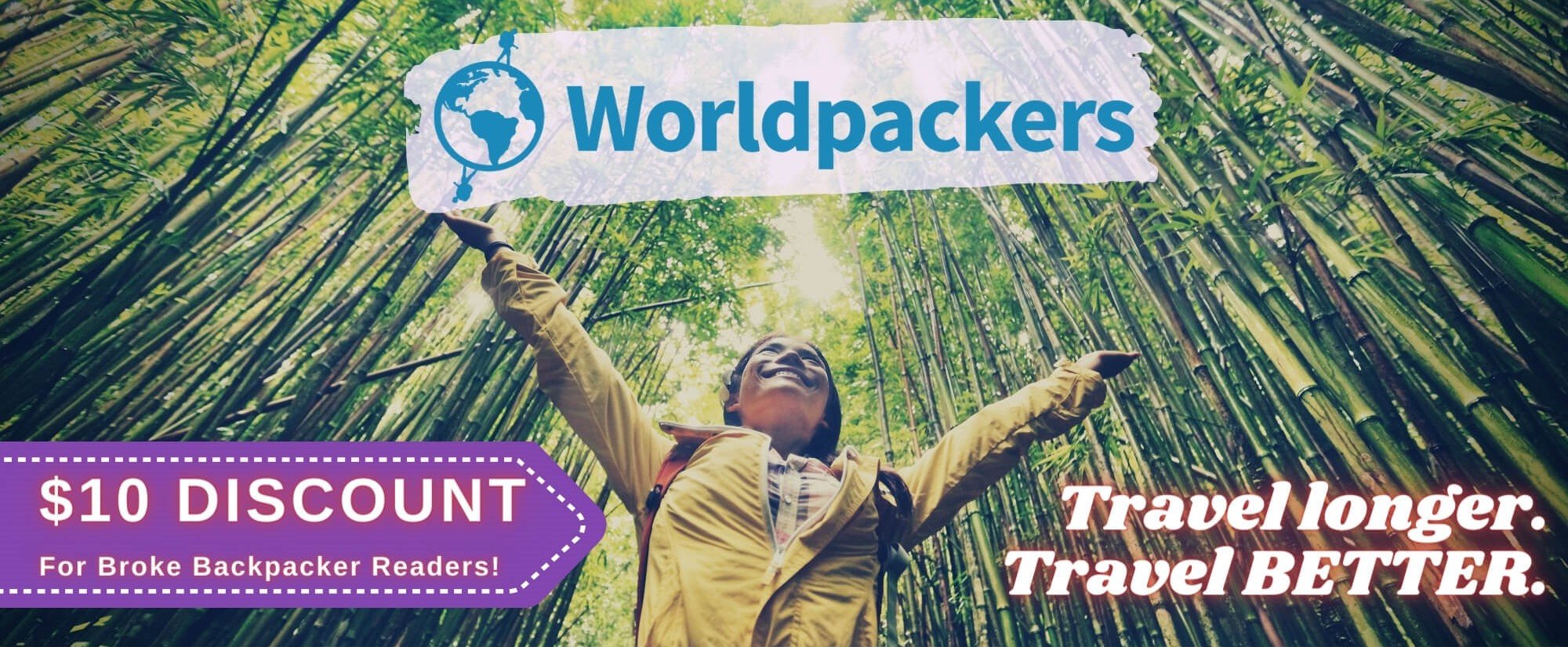
Worldpackers: connecting travellers with meaningful travel experiences.
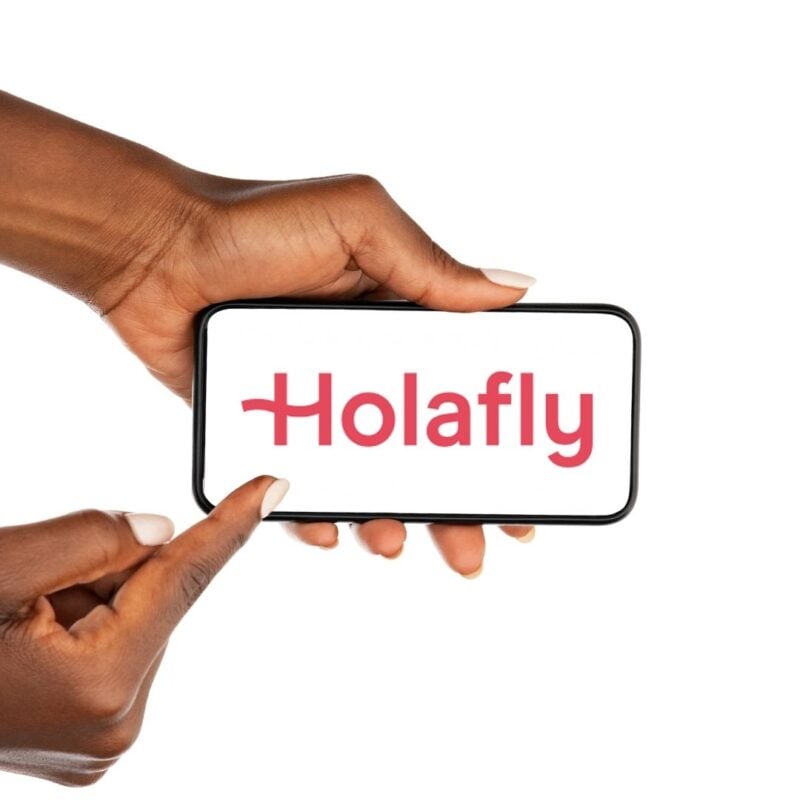
A new country, a new contract, a new piece of plastic – booooring. Instead, buy an eSIM!
An eSIM works just like an app: you buy it, you download it, and BOOM! You’re connected the minute you land. It’s that easy.
Is your phone eSIM ready? Read about how e-Sims work or click below to see one of the top eSIM providers on the market and ditch the plastic.
Grab an eSIM!Oceanic Culture
Across the Pacific, there is a very laid back culture. But it is not laziness even though that is how the Americans see it sometimes. It’s an investment in your community to stop and chat with your neighbours.
People from all walks of life in Oceania will go above and beyond in welcoming travellers to their home countries. I’ve had Cook Island aunties walk with me to a better market with cheaper prices simply because I complimented their garden and we got to talking.
New Zealand is far and away the best country I’ve ever hitchhiked in. Friends of friends will offer you a place to stay simply because you’re on the road and that’s the right thing to do – yay for new travel buddies!

And now, Australians might be gruff but they mean well. Even the old mate who asked me if I’d lost my marbles while looking for rocks was doing it out of care. He helped me replace my head gasket in the middle of the desert because it’s the right thing to do.
Always, there is humour.
There is a very collectivist streak across the Pacific cultures that extends to Australians as well. We care a lot for our mates down here – and if you backpack here long enough and pay your dues working on a farm you’re counted as one of us.
What to Eat in Oceania
Oceania is SUPER diverse – about 30% of Australian residents are born overseas. Fiji has strong Polynesian, Melanesian, Indian and Chinese roots. This incredible diversity of culture is reflected in the foods.
You can try a little bit of everything here – from soggy chips (this is actually a delicacy, don’t fight me on this) to fresh coconuts and delectable curries! Increasingly, Oceania is claiming its place as a leading wine and fine food destination. Through the diversity, there are strong themes of connection: fresh ingredients that are often seafood-based.
Now, I have worked in hospitality in Australia and (briefly) in New Zealand since I was a teenager. And let me tell you, it is brutal. In a good way, of course. It’s just in shaking off the image that Oceania is a cultural backwater whose citizens only appreciate soggy chips and boxed wine, the restaurateurs have gone a bit nuts.
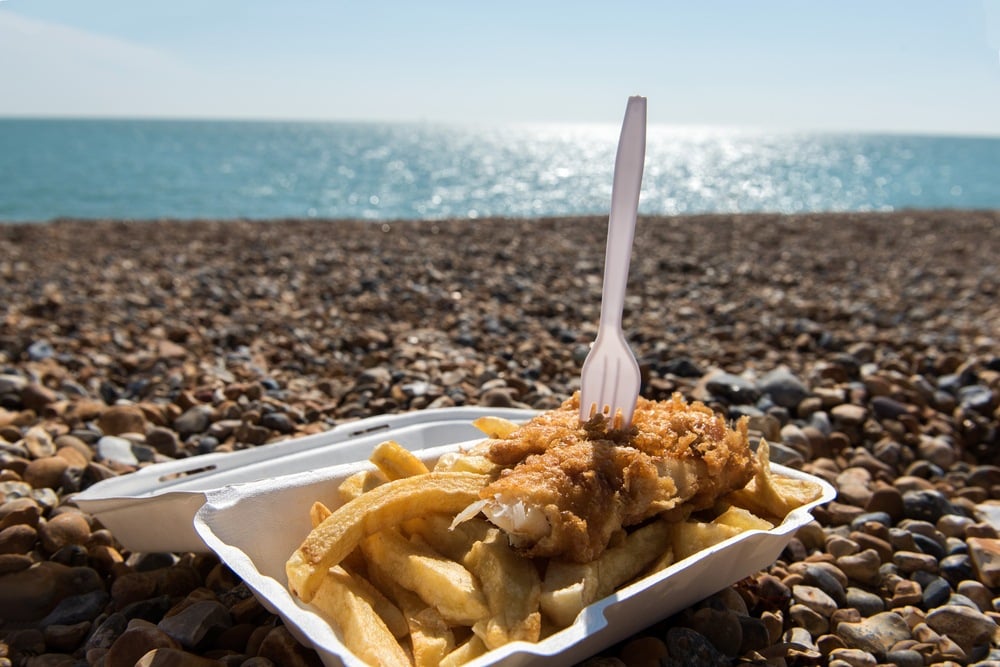
But in doing so, they have created some truly incredible dishes and a culinary experience like no other. The perks of being so multicultural mean that there are fusion dishes that will blow your mind. The Adelaide Central Market sells a million kilograms of fresh produce every month and hosts the best-tasting pho I’ve had outside of Vietnam.
There was a debate in Australian politics literally named “The Smashed Avo Debate” referencing the cultural love of brunch. Across Oceania, there is a focus on farm to table or sea to table dishes. You can ask your frazzled waitress exactly where this fish comes from and she’ll probably be able to tell you its name and social security number.
From fine dining to casual street eateries, Oceania is renowned for high-quality meals that are worth the hefty price tag.
Must-Try Dishes in Oceania
- Ika Mata. Fresh fish in lime with fresh vegetables and coconut milk. Best eaten with tuna although white fleshed fish works well, too.
- Poisson Crou. This is quite similar to Ika Mata. Usually it is fresh tuna marinated in lime juice and then mixed with fresh coconut milk and spring onions. Some variations will have rice as well.
- Palusami. Versions of this dish crop up across the Pacific and the Phillipines. It is fresh taro leaves filled with coconut, onion, and sometimes chicken or corned beef.
- Fish Suruwa. This Fijian curry uses spices familiar to Indian foods like garam masala to flavour coconut milk, white fish and rice.
- Smashed Avo: It’s in the name, but each cafe in Australia will have its own version of pureed avocado on toast. Usually eggs, feta, sourdough, and olive oil are involved. It has become a legendary hangover cure.
- Hot Chips drenched in vinegar. Deep fried potato chips will be crispy until you soak them in vinegar. They should once again become soggy. Even other Australians might come for me over this, but its the best way to eat your hot chips.
- Pavlova. This iconic dish has hazy origins – was it Russian originally? In typical Australian and Kiwi spirit, we have both claimed it as our own. It is a meringue based cake that is topped with fresh fruit and served at every Christmas.
- Haangi. Versions of of the haangi are endemic to the Pacific. You get your meat and vegetables – usually taro or kumara or yams – and cook them underground.
- Bluff Oysters – Have I mentioned these already? I hadn’t noticed. Bluff oysters are the best in the world. They’re BIG. Best eaten fresh with just a squeeze of lemon.
Some Unique Experiences in Oceania
These countries are a unique experience in and of themselves. The animals are weird, the landscapes verge on otherwordly, and the people are slightly nuts.
The diving might be legendary. The food might be divine. The wine is up and coming. The sailing is some of the best you’ll ever do. But there is one activity that Oceania can truly claim as its own.
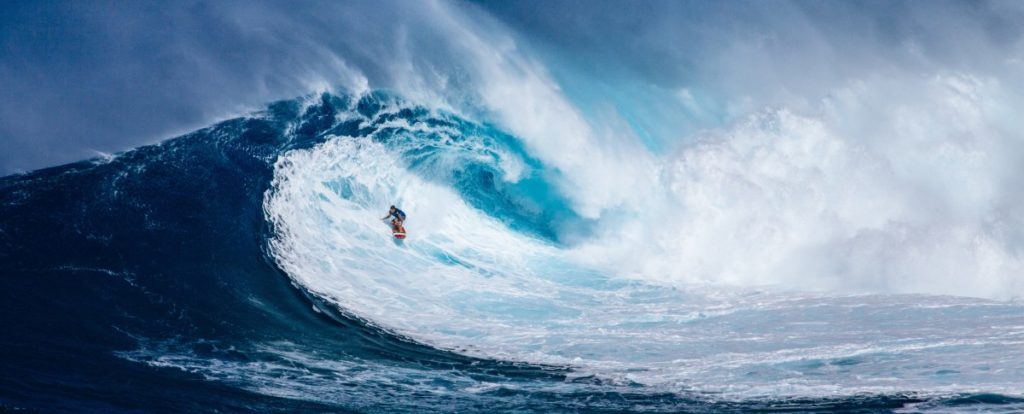
Surfing.
The best in the whole goddamn world.
Surfing in Oceania
Australia has over 12,000 beaches. New Zealand and the Pacific Islands are islands – that is, surrounded by water. Oceania has its fair share of reefs, rocks, and epic weather systems more influenced by La Nina/El Nino than by the traditional season. Yeah, ok, but what does this mean?
World. Class. Surfing.
I grew up near Margaret River which hosts the Margaret River Pro Surfing competition and produced surfers like Taj Burrow. Mainbreak is a dreamy left-hand break but other cheeky spots like Northpoint are righties.
Literally, wherever you go in Australia, damn fine surf breaks are not far behind. Surf culture has come to dominate almost every coastal town – but none more famously than Byron Bay. Byron itself has some good breaks – but it’s the surrounding areas like Lennox Head that takes the cake.

New Zealand’s answer to Byron Bay is Raglan. I got seriously churned up the first time I surfed Manu Bay, but it was a good time! Only in Raglan will people commit to surf culture so hard that they go barefoot in the middle of winter. Dunedin is New Zealand’s underrated surf spot. If you’re lucky, you’ll be surfing with cheeky fur seals and dolphins too.
Teahupoo needs no introduction to surfers. It is the legendary break on Tahiti that infamously breaks boards and cocky surfers. Over in Fiji, Cloudbreak is another break that needs a little introduction. And yet, nothing can prepare you for seeing it up close.
Throughout the Pacific you’ll find fucking incredible surfing of this calibre – but with no other people. 😉
FAQs About Backpacking Oceania
There are a few questions that the first time backpacker inevitably has about backpacking Oceania. How do I know this? I’m psychic, mate. 😉 Nah, not really – I had the same questions too! So here are the answer to the most frequently asked questions about backpacking Oceania.

Our GREATEST Travel Secrets…
Pop your email here & get the original Broke Backpacker Bible for FREE.
Final Advice Before Visiting Oceania
You’re in for one hell of a ride. I can give you a 10,000-word travel guide on where to go and what to do and how to do it all on the cheap, but nothing prepares you for backpacking Oceania. Not really.
The sunbaked centres and coral coasts compete for your attention with the dense jungles and tropical island paradises. Even across many lifetimes, you could not travel to every corner of Oceania. You can never really finish travelling here.
And that’s the beauty of it!
A string of communities is scattered across an area that is more ocean than land. By travelling Oceania you will find friendships and solitude that remind you why you left home in the first place.
“I love a sunburnt country/A land of sweeping plains,
Of ragged mountain ranges/Of droughts and flooding rains.
I love her far horizons/I love her jewel-sea,
Her beauty and her terror – it’s the wide brown land for me.”
– “My Country” by Dorothea Mackellar.
Damn, I always forget how my home countries turn me into a poetry-waxing hippy. But amongst the Pacific and across the Lands Down Under there is something undeniably magical.
What the hell are you waiting for mate? It’s time to travel to Oceania!
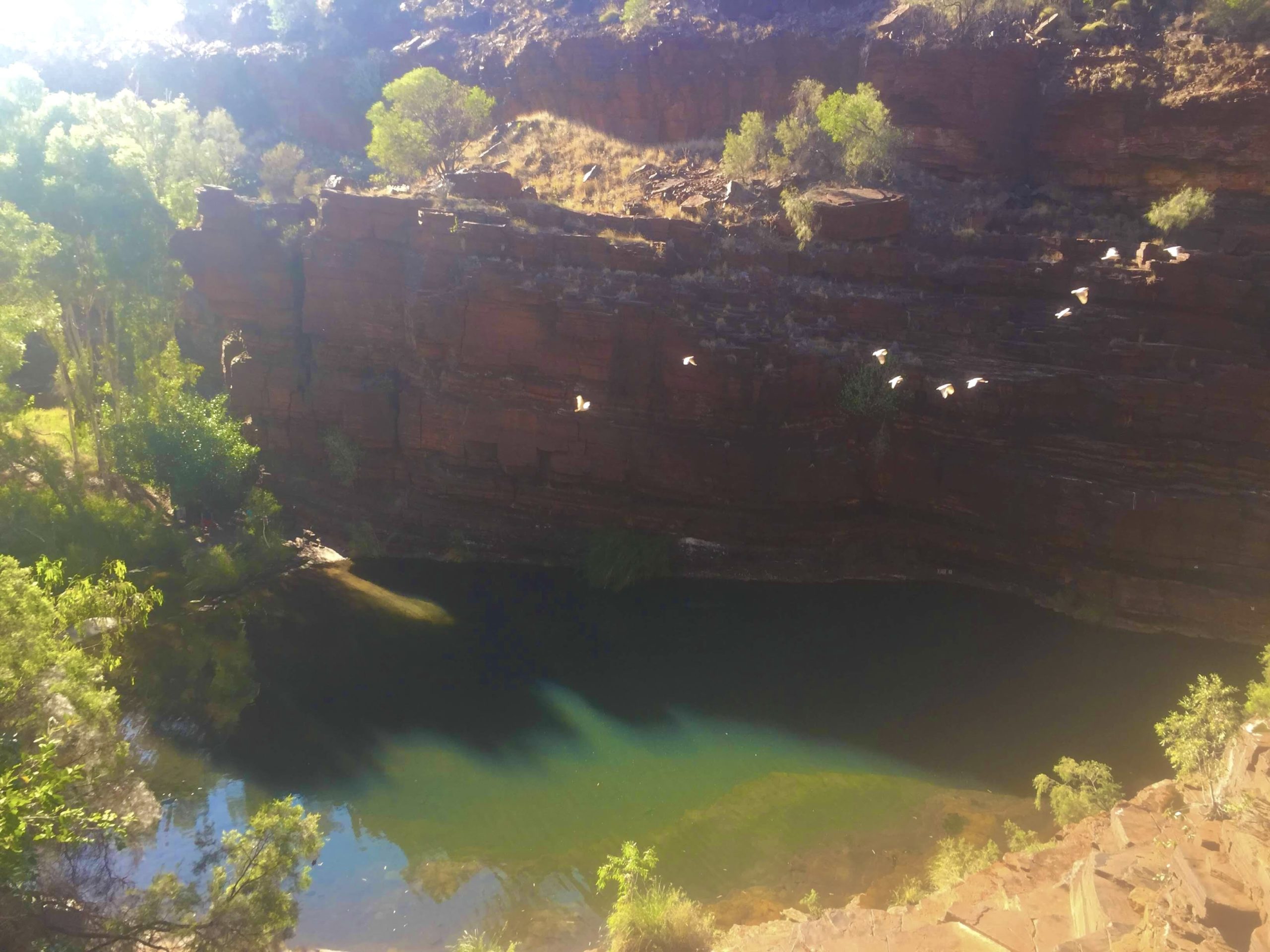
Photo: @indigogoinggone
Made it this far?
You get 15% OFF to book a place to stay!
Offer valid exclusively for Broke Backpackers 😉







